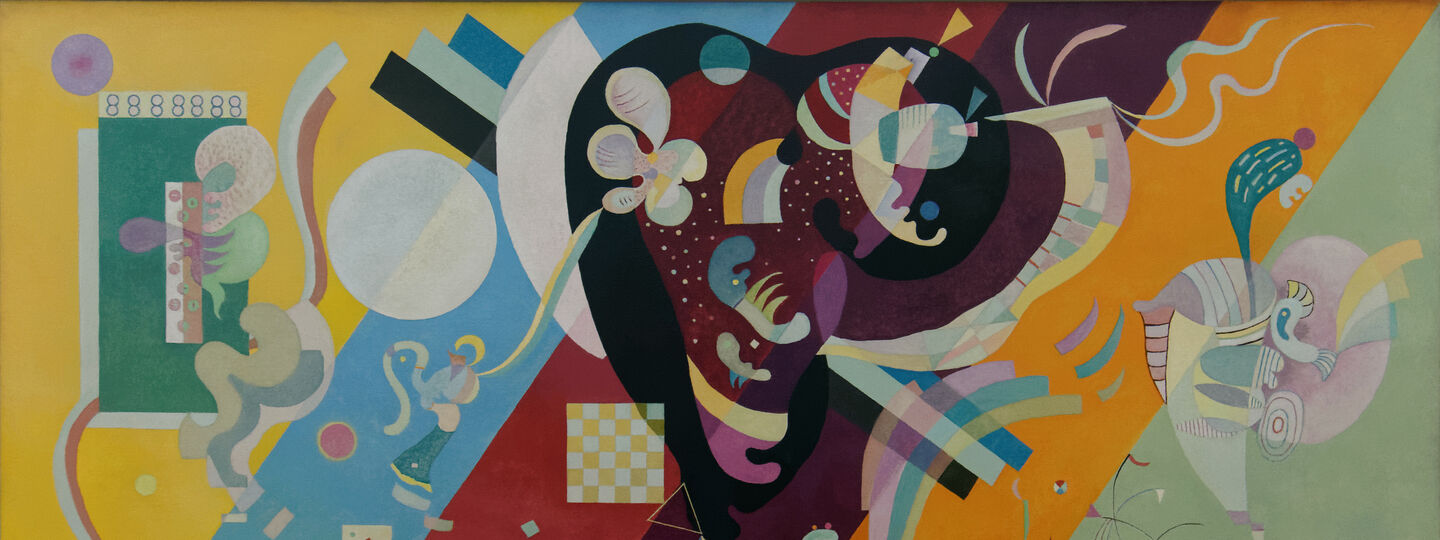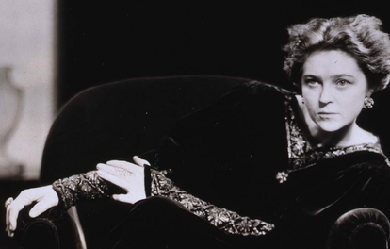
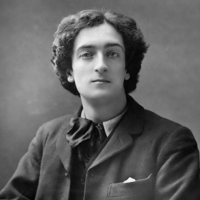
Richard Le Gallienne (20 January 1866– 15 September 1947) was an English author and poet. The American actress Eva Le Gallienne (1899–1991) was his daughter, by his second marriage. Life and career He was born in Liverpool. He started work in an accountant’s office, but abandoned this job to become a professional writer. The book My Ladies’ Sonnets appeared in 1887, and in 1889 he became, for a brief time, literary secretary to Wilson Barrett. He joined the staff of the newspaper The Star in 1891, and wrote for various papers by the name Logroller. He contributed to The Yellow Book, and associated with the Rhymers’ Club. His first wife, Mildred Lee, died in 1894. They had one daughter, Hesper. In 1897 he married the Danish journalist Julie Norregard, who left him in 1903 and took their daughter Eva to live in Paris. Le Gallienne subsequently became a resident of the United States. He has been credited with the 1906 translation from the Danish of Peter Nansen’s Love’s Trilogy; but most sources and the book itself attribute it to Julie. They were divorced in June 1911. On October 27, 1911, he married Mrs. Irma Perry, née Hinton, whose previous marriage to her first cousin, the painter and sculptor Roland Hinton Perry, had been dissolved in 1904. Le Gallienne and Irma had known each other for some time, and had jointly published an article as early as 1906. Irma’s daughter Gwendolyn Perry subsequently called herself “Gwen Le Gallienne”, but was almost certainly not his natural daughter, having been born in 1900. Le Gallienne and Irma lived in Paris from the late 1920s, where Gwen was by then an established figure in the expatriate bohéme (see, e.g.) and where he wrote a regular newspaper column. Le Gallienne lived in Menton on the French Riviera during the 1940s. During the Second World War Le Gallienne was prevented from returning to his Menton home and lived in Monaco for the rest of the war. Le Gallienne’s house in Menton was occupied by German troops and his library was nearly sent back to Germany as bounty. Le Gallienne appealed to a German officer in Monaco who allowed him to return to Menton to collect his books. During the war Le Gallienne refused to write propaganda for the local German and Italian authorities, and with no income, once collapsed in the street due to hunger. In later times he knew Llewelyn Powys and John Cowper Powys. Asked how to say his name, he told The Literary Digest the stress was “on the last syllable: le gal-i-enn’. As a rule I hear it pronounced as if it were spelled ‘gallion,’ which, of course, is wrong.” (Charles Earle Funk, What’s the Name, Please?, Funk & Wagnalls, 1936.) A number of his works are now available online. He also wrote the foreword to “The Days I Knew” by Lillie Langtry 1925, George H. Doran Company on Murray Hill New York. Works * My Ladies’ Sonnets and Other Vain and Amatorious Verses (1887) * Volumes in Folio (1889) poems * George Meredith: Some Characteristics (1890) * The Book-Bills of Narcissus (1891) * English Poems (1892) * The Religion of a Literary Man (1893) * Robert Louis Stevenson: An Elegy and Other Poems (1895) * Quest of the Golden Girl (1896) novel * Prose Fancies (1896) * Retrospective Reviews (1896) * Rubaiyat of Omar Khayyam (1897) * If I Were God (1897) * The Romance Of Zion Chapel (1898) * In Praise of Bishop Valentine (1898) * Young Lives (1899) * Sleeping Beauty and Other Prose Fancies (1900) * The Worshipper Of The Image (1900) * The Love Letters of the King, or The Life Romantic (1901) * An Old Country House (1902) * Odes from the Divan of Hafiz (1903) translation * Old Love Stories Retold (1904) * Painted Shadows (1904) * Romances of Old France (1905) * Little Dinners with the Sphinx and other Prose Fancies (1907) * Omar Repentant (1908) * Wagner’s Tristan and Isolde (1909) Translator * Attitudes and Avowals (1910) essays * October Vagabonds (1910) * New Poems (1910) * The Maker of Rainbows and Other Fairy-Tales and Fables (1912) * The Lonely Dancer and Other Poems (1913) * The Highway to Happiness (1913) * Vanishing Roads and Other Essays (1915) * The Silk-Hat Soldier and Other Poems in War Time (1915) * The Chain Invisible (1916) * Pieces of Eight (1918) * The Junk-Man and Other Poems (1920) * A Jongleur Strayed (1922) poems * Woodstock: An Essay (1923) * The Romantic '90s (1925) memoirs * The Romance of Perfume (1928) * There Was a Ship (1930) * From a Paris Garret (1936) memoirs * The Diary of Samuel Pepys (editor) References Wikipedia—https://en.wikipedia.org/wiki/Richard_Le_Gallienne
_and_brother_Ronald_-_Google_Art_Project.jpg)
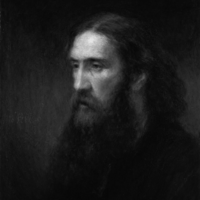
George MacDonald (10 December 1824– 18 September 1905) was a Scottish author, poet, and Christian minister. He was a pioneering figure in the field of fantasy literature and the mentor of fellow writer Lewis Carroll. His writings have been cited as a major literary influence by many notable authors including W. H. Auden, C. S. Lewis, J. R. R. Tolkien, Walter de la Mare, E. Nesbit and Madeleine L’Engle. C. S. Lewis wrote that he regarded MacDonald as his “master”: “Picking up a copy of Phantastes one day at a train-station bookstall, I began to read. A few hours later,” said Lewis, “I knew that I had crossed a great frontier.” G. K. Chesterton cited The Princess and the Goblin as a book that had “made a difference to my whole existence”. Elizabeth Yates wrote of Sir Gibbie, “It moved me the way books did when, as a child, the great gates of literature began to open and first encounters with noble thoughts and utterances were unspeakably thrilling.” Even Mark Twain, who initially disliked MacDonald, became friends with him, and there is some evidence that Twain was influenced by MacDonald. Christian author Oswald Chambers (1874–1917) wrote in Christian Disciplines, vol. 1, (pub. 1934) that “it is a striking indication of the trend and shallowness of the modern reading public that George MacDonald’s books have been so neglected”. In addition to his fairy tales, MacDonald wrote several works on Christian apologetics including several that defended his view of Christian Universalism. Early life George MacDonald was born on 10 December 1824 at Huntly, Aberdeenshire, Scotland. His father, a farmer, was one of the MacDonalds of Glen Coe, and a direct descendant of one of the families that suffered in the massacre of 1692. The Doric dialect of the Aberdeenshire area appears in the dialogue of some of his non-fantasy novels. MacDonald grew up in the Congregational Church, with an atmosphere of Calvinism. But MacDonald never felt comfortable with some aspects of Calvinist doctrine; indeed, legend has itt that when the doctrine of predestination was first explained to him, he burst into tears (although assured that he was one of the elect). Later novels, such as Robert Falconer and Lilith, show a distaste for the idea that God’s electing love is limited to some and denied to others. MacDonald graduated from the University of Aberdeen, and then went to London, studying at Highbury College for the Congregational ministry. In 1850 he was appointed pastor of Trinity Congregational Church, Arundel, but his sermons (preaching God’s universal love and the possibility that none would, ultimately, fail to unite with God) met with little favour and his salary was cut in half. Later he was engaged in ministerial work in Manchester. He left that because of poor health, and after a short sojourn in Algiers he settled in London and taught for some time at the University of London. MacDonald was also for a time editor of Good Words for the Young, and lectured successfully in the United States during 1872–1873. Work George MacDonald’s best-known works are Phantastes, The Princess and the Goblin, At the Back of the North Wind, and Lilith, all fantasy novels, and fairy tales such as “The Light Princess”, “The Golden Key”, and “The Wise Woman”. “I write, not for children,” he wrote, “but for the child-like, whether they be of five, or fifty, or seventy-five.” MacDonald also published some volumes of sermons, the pulpit not having proved an unreservedly successful venue. MacDonald also served as a mentor to Lewis Carroll (the pen-name of Rev. Charles Lutwidge Dodgson); it was MacDonald’s advice, and the enthusiastic reception of Alice by MacDonald’s many sons and daughters, that convinced Carroll to submit Alice for publication. Carroll, one of the finest Victorian photographers, also created photographic portraits of several of the MacDonald children. MacDonald was also friends with John Ruskin and served as a go-between in Ruskin’s long courtship with Rose La Touche. MacDonald was acquainted with most of the literary luminaries of the day; a surviving group photograph shows him with Tennyson, Dickens, Wilkie Collins, Trollope, Ruskin, Lewes, and Thackeray. While in America he was a friend of Longfellow and Walt Whitman. In 1877 he was given a civil list pension. From 1879 he and his family moved to Bordighera in a place much loved by British expatriates, the Riviera dei Fiori in Liguria, Italy, almost on the French border. In that locality there also was an Anglican Church, which he attended. Deeply enamoured of the Riviera, he spent there 20 years, writing almost half of his whole literary production, especially the fantasy work. In that Ligurian town MacDonald founded a literary studio named Casa Coraggio (Bravery House), which soon became one of the most renowned cultural centres of that period, well attended by British and Italian travellers, and by locals. In that house representations were often held of classic plays, and readings were given of Dante and Shakespeare. In 1900 he moved into St George’s Wood, Haslemere, a house designed for him by his son, Robert Falconer MacDonald, and the building overseen by his eldest son, Greville MacDonald. He died on 18 September 1905 in Ashtead, (Surrey). He was cremated and his ashes buried in Bordighera, in the English cemetery, along with his wife Louisa and daughters Lilia and Grace. As hinted above, MacDonald’s use of fantasy as a literary medium for exploring the human condition greatly influenced a generation of such notable authors as C. S. Lewis (who featured him as a character in his The Great Divorce), J. R. R. Tolkien, and Madeleine L’Engle. MacDonald’s non-fantasy novels, such as Alec Forbes, had their influence as well; they were among the first realistic Scottish novels, and as such MacDonald has been credited with founding the “kailyard school” of Scottish writing. His son Greville MacDonald became a noted medical specialist, a pioneer of the Peasant Arts movement, and also wrote numerous fairy tales for children. Greville ensured that new editions of his father’s works were published. Another son, Ronald MacDonald, was also a novelist. Ronald’s son, Philip MacDonald, (George MacDonald’s grandson) became a very well known Hollywood screenwriter. Theology MacDonald rejected the doctrine of penal substitutionary atonement as developed by John Calvin, which argues that Christ has taken the place of sinners and is punished by the wrath of God in their place, believing that in turn it raised serious questions about the character and nature of God. Instead, he taught that Christ had come to save people from their sins, and not from a Divine penalty for their sins. The problem was not the need to appease a wrathful God but the disease of cosmic evil itself. George MacDonald frequently described the Atonement in terms similar to the Christus Victor theory. MacDonald posed the rhetorical question, “Did he not foil and slay evil by letting all the waves and billows of its horrid sea break upon him, go over him, and die without rebound—spend their rage, fall defeated, and cease? Verily, he made atonement!” MacDonald was convinced that God does not punish except to amend, and that the sole end of His greatest anger is the amelioration of the guilty. As the doctor uses fire and steel in certain deep-seated diseases, so God may use hell-fire if necessary to heal the hardened sinner. MacDonald declared, “I believe that no hell will be lacking which would help the just mercy of God to redeem his children.” MacDonald posed the rhetorical question, “When we say that God is Love, do we teach men that their fear of Him is groundless?” He replied, “No. As much as they fear will come upon them, possibly far more.... The wrath will consume what they call themselves; so that the selves God made shall appear.” However, true repentance, in the sense of freely chosen moral growth, is essential to this process, and, in MacDonald’s optimistic view, inevitable for all beings (see universal reconciliation). He recognised the theoretical possibility that, bathed in the eschatological divine light, some might perceive right and wrong for what they are but still refuse to be transfigured by operation of God’s fires of love, but he did not think this likely. In this theology of divine punishment, MacDonald stands in opposition to Augustine of Hippo, and in agreement with the Greek Church Fathers Clement of Alexandria, Origen, and St. Gregory of Nyssa, although it is unknown whether MacDonald had a working familiarity with Patristics or Eastern Orthodox Christianity. At least an indirect influence is likely, because F. D. Maurice, who influenced MacDonald, knew the Greek Fathers, especially Clement, very well. MacDonald states his theological views most distinctly in the sermon Justice found in the third volume of Unspoken Sermons. In his introduction to George MacDonald: An Anthology, C. S. Lewis speaks highly of MacDonald’s theology: “This collection, as I have said, was designed not to revive MacDonald’s literary reputation but to spread his religious teaching. Hence most of my extracts are taken from the three volumes of Unspoken Sermons. My own debt to this book is almost as great as one man can owe to another: and nearly all serious inquirers to whom I have introduced it acknowledge that it has given them great help—sometimes indispensable help toward the very acceptance of the Christian faith. ... I know hardly any other writer who seems to be closer, or more continually close, to the Spirit of Christ Himself. Hence his Christ-like union of tenderness and severity. Nowhere else outside the New Testament have I found terror and comfort so intertwined.... In making this collection I was discharging a debt of justice. I have never concealed the fact that I regarded him as my master; indeed I fancy I have never written a book in which I did not quote from him. But it has not seemed to me that those who have received my books kindly take even now sufficient notice of the affiliation. Honesty drives me to emphasize it.” Bibliography Fantasy * Phantastes: A Fairie Romance for Men and Women (1858) * “Cross Purposes” (1862) * Adela Cathcart (1864), containing “The Light Princess”, “The Shadows”, and other short stories * The Portent: A Story of the Inner Vision of the Highlanders, Commonly Called “The Second Sight” (1864) * Dealings with the Fairies (1867), containing “The Golden Key”, “The Light Princess”, “The Shadows”, and other short stories * At the Back of the North Wind (1871) * Works of Fancy and Imagination (1871), including Within and Without, “Cross Purposes”, “The Light Princess”, “The Golden Key”, and other works * The Princess and the Goblin (1872) * The Wise Woman: A Parable (1875) (Published also as “The Lost Princess: A Double Story”; or as “A Double Story”.) * The Gifts of the Child Christ and Other Tales (1882; republished as Stephen Archer and Other Tales) * The Day Boy and the Night Girl (1882) * The Princess and Curdie (1883), a sequel to The Princess and the Goblin * The Flight of the Shadow (1891) * Lilith: A Romance (1895) Realistic fiction * David Elginbrod (1863; republished as The Tutor’s First Love), originally published in three volumes * Alec Forbes of Howglen (1865; republished as The Maiden’s Bequest) * Annals of a Quiet Neighbourhood (1867) * Guild Court: A London Story (1868) * Robert Falconer (1868; republished as The Musician’s Quest) * The Seaboard Parish (1869), a sequel to Annals of a Quiet Neighbourhood * Ranald Bannerman’s Boyhood (1871) * Wilfrid Cumbermede (1871–72) * The Vicar’s Daughter (1871–72), a sequel to Annals of a Quiet Neighborhood and The Seaboard Parish * The History of Gutta Percha Willie, the Working Genius (1873), usually called simply Gutta Percha Willie * Malcolm (1875) * St. George and St. Michael (1876) * Thomas Wingfold, Curate (1876; republished as The Curate’s Awakening) * The Marquis of Lossie (1877; republished as The Marquis’ Secret), the second book of Malcolm * Paul Faber, Surgeon (1879; republished as The Lady’s Confession), a sequel to Thomas Wingfold, Curate * Sir Gibbie (1879; republished as The Baronet’s Song) * Mary Marston (1881; republished as A Daughter’s Devotion) * Warlock o’ Glenwarlock (1881; republished as Castle Warlock and The Laird’s Inheritance) * Weighed and Wanting (1882; republished as A Gentlewoman’s Choice) * Donal Grant (1883; republished as The Shepherd’s Castle), a sequel to Sir Gibbie * What’s Mine’s Mine (1886; republished as The Highlander’s Last Song) * Home Again: A Tale (1887; republished as The Poet’s Homecoming) * The Elect Lady (1888; republished as The Landlady’s Master) * A Rough Shaking (1891) * There and Back (1891; republished as The Baron’s Apprenticeship), a sequel to Thomas Wingfold, Curate and Paul Faber, Surgeon * Heather and Snow (1893; republished as The Peasant Girl’s Dream) * Salted with Fire (1896; republished as The Minister’s Restoration) * Far Above Rubies (1898) Poetry * Twelve of the Spiritual Songs of Novalis (1851), privately printed translation of the poetry of Novalis * Within and Without: A Dramatic Poem (1855) * Poems (1857) * “A Hidden Life” and Other Poems (1864) * “The Disciple” and Other Poems (1867) * Exotics: A Translation of the Spiritual Songs of Novalis, the Hymn-book of Luther, and Other Poems from the German and Italian (1876) * Dramatic and Miscellaneous Poems (1876) * Diary of an Old Soul (1880) * A Book of Strife, in the Form of the Diary of an Old Soul (1880), privately printed * The Threefold Cord: Poems by Three Friends (1883), privately printed, with Greville Matheson and John Hill MacDonald * Poems (1887) * The Poetical Works of George MacDonald, 2 Volumes (1893) * Scotch Songs and Ballads (1893) * Rampolli: Growths from a Long-planted Root (1897) Nonfiction * Unspoken Sermons (1867) * England’s Antiphon (1868, 1874) * The Miracles of Our Lord (1870) * Cheerful Words from the Writing of George MacDonald (1880), compiled by E. E. Brown * Orts: Chiefly Papers on the Imagination, and on Shakespeare (1882) * “Preface” (1884) to Letters from Hell (1866) by Valdemar Adolph Thisted * The Tragedie of Hamlet, Prince of Denmarke: A Study With the Test of the Folio of 1623 (1885) * Unspoken Sermons, Second Series (1885) * Unspoken Sermons, Third Series (1889) * A Cabinet of Gems, Cut and Polished by Sir Philip Sidney; Now, for the More Radiance, Presented Without Their Setting by George MacDonald (1891) * The Hope of the Gospel (1892) * A Dish of Orts (1893) * Beautiful Thoughts from George MacDonald (1894), compiled by Elizabeth Dougall In popular culture * (Alphabetical by artist) * Christian celtic punk band Ballydowse have a song called “George MacDonald” on their album Out of the Fertile Crescent. The song is both taken from MacDonald’s poem “My Two Geniuses” and liberally quoted from Phantastes. * American classical composer John Craton has utilized several of MacDonald’s stories in his works, including “The Gray Wolf” (in a tone poem of the same name for solo mandolin– 2006) and portions of “The Cruel Painter”, Lilith, and The Light Princess (in Three Tableaux from George MacDonald for mandolin, recorder, and cello– 2011). * Contemporary new-age musician Jeff Johnson wrote a song titled “The Golden Key” based on George MacDonald’s story of the same name. He has also written several other songs inspired by MacDonald and the Inklings. * Jazz pianist and recording artist Ray Lyon has a song on his CD Beginning to See (2007), called “Up The Spiral Stairs”, which features lyrics from MacDonald’s 26 and 27 September devotional readings from the book Diary of an Old Soul. * A verse from The Light Princess is cited in the “Beauty and the Beast” song by Nightwish. * Rock group The Waterboys titled their album Room to Roam (1990) after a passage in MacDonald’s Phantastes, also found in Lilith. The title track of the album comprises a MacDonald poem from the text of Phantastes set to music by the band. The novels Lilith and Phantastes are both named as books in a library, in the title track of another Waterboys album, Universal Hall (2003). (The Waterboys have also quoted from C. S. Lewis in several songs, including “Church Not Made With Hands” and “Further Up, Further In”, confirming the enduring link in modern pop culture between MacDonald and Lewis.) References Wikipedia—https://en.wikipedia.org/wiki/George_MacDonald
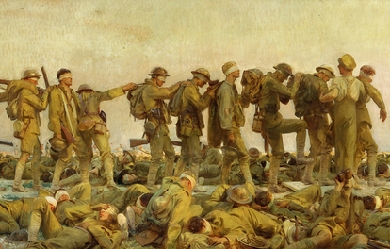
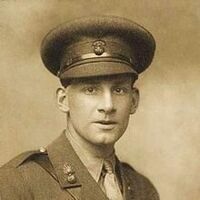
Siegfried Loraine Sassoon (8 September 1886 – 1 September 1967) was an English poet, author and soldier. Decorated for bravery on the Western Front, he became one of the leading poets of the First World War. His poetry both described the horrors of the trenches, and satirised the patriotic pretensions of those who, in Sassoon's view, were responsible for a vainglorious war. He later won acclaim for his prose work, notably his three-volume fictionalised autobiography, collectively known as the "Sherston Trilogy". Motivated by patriotism, Sassoon joined the British Army just as the threat of World War I was realised, and was in service with the Sussex Yeomanry on the day the United Kingdom declared war (4 August 1914). He broke his arm badly in a riding accident and was put out of action before even leaving England, spending the spring of 1915 convalescing.
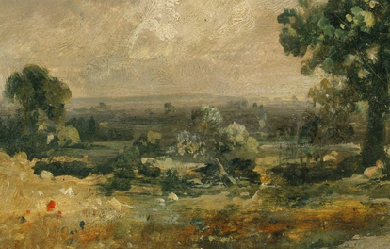
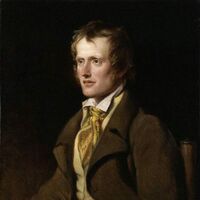
John Clare (13 July 1793 – 20 May 1864) was an English poet, the son of a farm labourer, who came to be known for his celebratory representations of the English countryside and his lamentation of its disruption. His poetry underwent a major re-evaluation in the late 20th century and he is often now considered to be among the most important 19th-century poets. His biographer Jonathan Bate states that Clare was "the greatest labouring-class poet that England has ever produced. No one has ever written more powerfully of nature, of a rural childhood, and of the alienated and unstable self”. Early life Clare was born in Helpston, six miles to the north of the city of Peterborough. In his life time, the village was in the Soke of Peterborough in Northamptonshire and his memorial calls him "The Northamptonshire Peasant Poet". Helpston now lies in the Peterborough unitary authority of Cambridgeshire. He became an agricultural labourer while still a child; however, he attended school in Glinton church until he was twelve. In his early adult years, Clare became a pot-boy in the Blue Bell public house and fell in love with Mary Joyce; but her father, a prosperous farmer, forbade her to meet him. Subsequently he was a gardener at Burghley House. He enlisted in the militia, tried camp life with Gypsies, and worked in Pickworth as a lime burner in 1817. In the following year he was obliged to accept parish relief. Malnutrition stemming from childhood may be the main culprit behind his 5-foot stature and may have contributed to his poor physical health in later life. Early poems Clare had bought a copy of Thomson's Seasons and began to write poems and sonnets. In an attempt to hold off his parents' eviction from their home, Clare offered his poems to a local bookseller named Edward Drury. Drury sent Clare's poetry to his cousin John Taylor of the publishing firm of Taylor & Hessey, who had published the work of John Keats. Taylor published Clare's Poems Descriptive of Rural Life and Scenery in 1820. This book was highly praised, and in the next year his Village Minstrel and other Poems were published. Midlife He had married Martha ("Patty") Turner in 1820. An annuity of 15 guineas from the Marquess of Exeter, in whose service he had been, was supplemented by subscription, so that Clare became possessed of £45 annually, a sum far beyond what he had ever earned. Soon, however, his income became insufficient, and in 1823 he was nearly penniless. The Shepherd's Calendar (1827) met with little success, which was not increased by his hawking it himself. As he worked again in the fields his health temporarily improved; but he soon became seriously ill. Earl FitzWilliam presented him with a new cottage and a piece of ground, but Clare could not settle in his new home. Clare was constantly torn between the two worlds of literary London and his often illiterate neighbours; between the need to write poetry and the need for money to feed and clothe his children. His health began to suffer, and he had bouts of severe depression, which became worse after his sixth child was born in 1830 and as his poetry sold less well. In 1832, his friends and his London patrons clubbed together to move the family to a larger cottage with a smallholding in the village of Northborough, not far from Helpston. However, he felt only more alienated. His last work, the Rural Muse (1835), was noticed favourably by Christopher North and other reviewers, but this was not enough to support his wife and seven children. Clare's mental health began to worsen. As his alcohol consumption steadily increased along with his dissatisfaction with his own identity, Clare's behaviour became more erratic. A notable instance of this behaviour was demonstrated in his interruption of a performance of The Merchant of Venice, in which Clare verbally assaulted Shylock. He was becoming a burden to Patty and his family, and in July 1837, on the recommendation of his publishing friend, John Taylor, Clare went of his own volition (accompanied by a friend of Taylor's) to Dr Matthew Allen's private asylum High Beach near Loughton, in Epping Forest. Taylor had assured Clare that he would receive the best medical care. Later life and death During his first few asylum years in Essex (1837–1841), Clare re-wrote famous poems and sonnets by Lord Byron. His own version of Child Harold became a lament for past lost love, and Don Juan, A Poem became an acerbic, misogynistic, sexualised rant redolent of an aging Regency dandy. Clare also took credit for Shakespeare's plays, claiming to be the Renaissance genius himself. "I'm John Clare now," the poet claimed to a newspaper editor, "I was Byron and Shakespeare formerly." In 1841, Clare left the asylum in Essex, to walk home, believing that he was to meet his first love Mary Joyce; Clare was convinced that he was married with children to her and Martha as well. He did not believe her family when they told him she had died accidentally three years earlier in a house fire. He remained free, mostly at home in Northborough, for the five months following, but eventually Patty called the doctors in. Between Christmas and New Year in 1841, Clare was committed to the Northampton General Lunatic Asylum (now St Andrew's Hospital). Upon Clare's arrival at the asylum, the accompanying doctor, Fenwick Skrimshire, who had treated Clare since 1820, completed the admission papers. To the enquiry "Was the insanity preceded by any severe or long-continued mental emotion or exertion?", Dr Skrimshire entered: "After years of poetical prosing." He remained here for the rest of his life under the humane regime of Dr Thomas Octavius Prichard, encouraged and helped to write. Here he wrote possibly his most famous poem, I Am. He died on 20 May 1864, in his 71st year. His remains were returned to Helpston for burial in St Botolph’s churchyard. Today, children at the John Clare School, Helpston's primary, parade through the village and place their 'midsummer cushions' around Clare's gravestone (which has the inscriptions "To the Memory of John Clare The Northamptonshire Peasant Poet" and "A Poet is Born not Made") on his birthday, in honour of their most famous resident. The thatched cottage where he was born was bought by the John Clare Education & Environment Trust in 2005 and is restoring the cottage to its 18th century state. Poetry In his time, Clare was commonly known as "the Northamptonshire Peasant Poet". Since his formal education was brief, Clare resisted the use of the increasingly standardised English grammar and orthography in his poetry and prose. Many of his poems would come to incorporate terms used locally in his Northamptonshire dialect, such as 'pooty' (snail), 'lady-cow' (ladybird), 'crizzle' (to crisp) and 'throstle' (song thrush). In his early life he struggled to find a place for his poetry in the changing literary fashions of the day. He also felt that he did not belong with other peasants. Clare once wrote "I live here among the ignorant like a lost man in fact like one whom the rest seemes careless of having anything to do with—they hardly dare talk in my company for fear I should mention them in my writings and I find more pleasure in wandering the fields than in musing among my silent neighbours who are insensible to everything but toiling and talking of it and that to no purpose.” It is common to see an absence of punctuation in many of Clare's original writings, although many publishers felt the need to remedy this practice in the majority of his work. Clare argued with his editors about how it should be presented to the public. Clare grew up during a period of massive changes in both town and countryside as the Industrial Revolution swept Europe. Many former agricultural workers, including children, moved away from the countryside to over-crowded cities, following factory work. The Agricultural Revolution saw pastures ploughed up, trees and hedges uprooted, the fens drained and the common land enclosed. This destruction of a centuries-old way of life distressed Clare deeply. His political and social views were predominantly conservative ("I am as far as my politics reaches 'King and Country'—no Innovations in Religion and Government say I."). He refused even to complain about the subordinate position to which English society relegated him, swearing that "with the old dish that was served to my forefathers I am content." His early work delights both in nature and the cycle of the rural year. Poems such as Winter Evening, Haymaking and Wood Pictures in Summer celebrate the beauty of the world and the certainties of rural life, where animals must be fed and crops harvested. Poems such as Little Trotty Wagtail show his sharp observation of wildlife, though The Badger shows his lack of sentiment about the place of animals in the countryside. At this time, he often used poetic forms such as the sonnet and the rhyming couplet. His later poetry tends to be more meditative and use forms similar to the folks songs and ballads of his youth. An example of this is Evening. His knowledge of the natural world went far beyond that of the major Romantic poets. However, poems such as I Am show a metaphysical depth on a par with his contemporary poets and many of his pre-asylum poems deal with intricate play on the nature of linguistics. His 'bird's nest poems', it can be argued, illustrate the self-awareness, and obsession with the creative process that captivated the romantics. Clare was the most influential poet, aside from Wordsworth to practice in an older style. Revival of interest in the twentieth century Clare was relatively forgotten during the later nineteenth century, but interest in his work was revived by Arthur Symons in 1908, Edmund Blunden in 1920 and John and Anne Tibble in their ground-breaking 1935 2-volume edition. Benjamin Britten set some of 'May' from A Shepherd's Calendar in his Spring Symphony of 1948, and included a setting of The Evening Primrose in his Five Flower Songs Copyright to much of his work has been claimed since 1965 by the editor of the Complete Poetry (OUP, 9 vols., 1984–2003), Professor Eric Robinson though these claims were contested. Recent publishers have refused to acknowledge the claim (especially in recent editions from Faber and Carcanet) and it seems the copyright is now defunct. The John Clare Trust purchased Clare Cottage in Helpston in 2005, preserving it for future generations. In May 2007 the Trust gained £1.m of funding from the Heritage Lottery Fund and commissioned Jefferson Sheard Architects to create the new landscape design and Visitor Centre, including a cafe, shop and exhibition space. The Cottage has been restored using traditional building methods and opened to the public. The largest collection of original Clare manuscripts are housed at Peterborough Museum, where they are available to view by appointment. Since 1993, the John Clare Society of North America has organised an annual session of scholarly papers concerning John Clare at the annual Convention of the Modern Language Association of America. Poetry collections by Clare (chronological) * Poems Descriptive of Rural Life and Scenery. London, 1820. * The Village Minstrel, and Other Poems. London, 1821. * The Shepherd's Calendar with Village Stories and Other Poems. London, 1827 * The Rural Muse. London, 1835. * Sonnet. London 1841 * First Love * Snow Storm. * The Firetail. * The Badger – Time unknown References Wikipedia - http://en.wikipedia.org/wiki/John_Clare
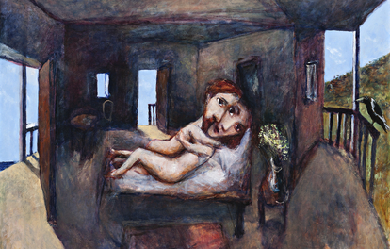
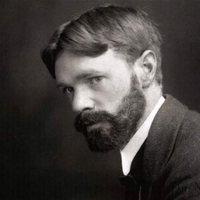
David Herbert Richards Lawrence (11 September 1885 – 2 March 1930) was an English novelist, poet, playwright, essayist, literary critic and painter who published as D. H. Lawrence. His collected works represent an extended reflection upon the dehumanising effects of modernity and industrialisation. In them, Lawrence confronts issues relating to emotional health and vitality, spontaneity, and instinct. Lawrence’s opinions earned him many enemies and he endured official persecution, censorship, and misrepresentation of his creative work throughout the second half of his life, much of which he spent in a voluntary exile which he called his “savage pilgrimage”. At the time of his death, his public reputation was that of a pornographer who had wasted his considerable talents. E. M. Forster, in an obituary notice, challenged this widely held view, describing him as, “The greatest imaginative novelist of our generation”. Later, the influential Cambridge critic F. R. Leavis championed both his artistic integrity and his moral seriousness, placing much of Lawrence's fiction within the canonical “great tradition” of the English novel. Lawrence is now valued by many as a visionary thinker and significant representative of modernism in English literature.
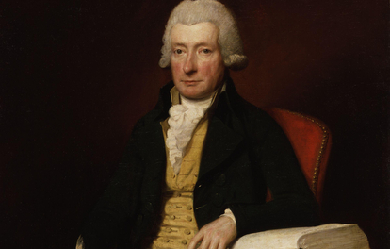
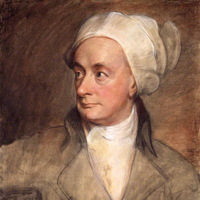
William Cowper (26 November 1731– 25 April 1800) was an English poet and hymnodist. One of the most popular poets of his time, Cowper changed the direction of 18th century nature poetry by writing of everyday life and scenes of the English countryside. In many ways, he was one of the forerunners of Romantic poetry. Samuel Taylor Coleridge called him “the best modern poet”, whilst William Wordsworth particularly admired his poem Yardley-Oak. He was a nephew of the poet Judith Madan.
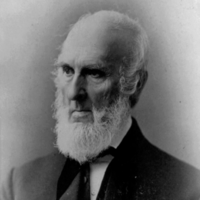
John Greenleaf Whittier (December 17, 1807 – September 7, 1892) was an American Quaker poet and advocate of the abolition of slavery in the United States. Frequently listed as one of the Fireside Poets, he was influenced by the Scottish poet Robert Burns. Whittier is remembered particularly for his anti-slavery writings as well as his book Snow-Bound. Early life and work John Greenleaf Whittier was born to John and Abigail (Hussey) at their rural homestead in Haverhill, Massachusetts, on December 17, 1807. His middle name is thought to mean 'feuillevert' after his Huguenot forbears. He grew up on the farm in a household with his parents, a brother and two sisters, a maternal aunt and paternal uncle, and a constant flow of visitors and hired hands for the farm. As a boy, it was discovered that Whittier was color-blind when he was unable to see a difference between ripe and unripe strawberries. Their farm was not very profitable and there was only enough money to get by. Whittier himself was not cut out for hard farm labor and suffered from bad health and physical frailty his whole life. Although he received little formal education, he was an avid reader who studied his father's six books on Quakerism until their teachings became the foundation of his ideology. Whittier was heavily influenced by the doctrines of his religion, particularly its stress on humanitarianism, compassion, and social responsibility. Whittier was first introduced to poetry by a teacher. His sister sent his first poem, "The Exile's Departure", to the Newburyport Free Press without his permission and its editor, William Lloyd Garrison, published it on June 8, 1826. Garrison as well as another local editor encouraged Whittier to attend the recently opened Haverhill Academy. To raise money to attend the school, Whittier became a shoemaker for a time, and a deal was made to pay part of his tuition with food from the family farm. Before his second term, he earned money to cover tuition by serving as a teacher in a one-room schoolhouse in what is now Merrimac, Massachusetts. He attended Haverhill Academy from 1827 to 1828 and completed a high school education in only two terms. Garrison gave Whittier the job of editor of the National Philanthropist, a Boston-based temperance weekly. Shortly after a change in management, Garrison reassigned him as editor of the weekly American Manufacturer in Boston. Whittier became an out-spoken critic of President Andrew Jackson, and by 1830 was editor of the prominent New England Weekly Review in Hartford, Connecticut, the most influential Whig journal in New England. In 1833 he published The Song of the Vermonters, 1779, which he had anonymously inserted in The New England Magazine. The poem was erroneously attributed to Ethan Allen for nearly sixty years. Abolitionist activity During the 1830s, Whittier became interested in politics but, after losing a Congressional election at age twenty-five, he suffered a nervous breakdown and returned home. The year 1833 was a turning point for Whittier; he resurrected his correspondence with Garrison, and the passionate abolitionist began to encourage the young Quaker to join his cause. In 1833, Whittier published the antislavery pamphlet Justice and Expediency, and from there dedicated the next twenty years of his life to the abolitionist cause. The controversial pamphlet destroyed all of his political hopes — as his demand for immediate emancipation alienated both northern businessmen and southern slaveholders — but it also sealed his commitment to a cause that he deemed morally correct and socially necessary. He was a founding member of the American Anti-Slavery Society and signed the Anti-Slavery Declaration of 1833, which he often considered the most significant action of his life. Whittier's political skill made him useful as a lobbyist, and his willingness to badger anti-slavery congressional leaders into joining the abolitionist cause was invaluable. From 1835 to 1838, he traveled widely in the North, attending conventions, securing votes, speaking to the public, and lobbying politicians. As he did so, Whittier received his fair share of violent responses, being several times mobbed, stoned, and run out of town. From 1838 to 1840, he was editor of The Pennsylvania Freeman in Philadelphia, one of the leading antislavery papers in the North, formerly known as the National Enquirer. In May 1838, the publication moved its offices to the newly opened Pennsylvania Hall on North Sixth Street, which was shortly after burned by a pro-slavery mob. Whittier also continued to write poetry and nearly all of his poems in this period dealt with the problem of slavery. By the end of the 1830s, the unity of the abolitionist movement had begun to fracture. Whittier stuck to his belief that moral action apart from political effort was futile. He knew that success required legislative change, not merely moral suasion. This opinion alone engendered a bitter split from Garrison,[citation needed] and Whittier went on to become a founding member of the Liberty Party in 1839. In 1840 he attended the World Anti-Slavery Convention in London. By 1843, he was announcing the triumph of the fledgling party: "Liberty party is no longer an experiment. It is vigorous reality, exerting... a powerful influence". Whittier also unsuccessfully encouraged Ralph Waldo Emerson and Henry Wadsworth Longfellow to join the party. He took editing jobs with the Middlesex Standard in Lowell, Massachusetts and the Essex Transcript in Amesbury until 1844. While in Lowell, he met Lucy Larcom, who became a lifelong friend. In 1845, he began writing his essay "The Black Man" which included an anecdote about John Fountain, a free black who was jailed in Virginia for helping slaves escape. After his release, Fountain went on a speaking tour and thanked Whittier for writing his story. Around this time, the stresses of editorial duties, worsening health, and dangerous mob violence caused him to have a physical breakdown. Whittier went home to Amesbury, and remained there for the rest of his life, ending his active participation in abolition. Even so, he continued to believe that the best way to gain abolitionist support was to broaden the Liberty Party's political appeal, and Whittier persisted in advocating the addition of other issues to their platform. He eventually participated in the evolution of the Liberty Party into the Free Soil Party, and some say his greatest political feat was convincing Charles Sumner to run on the Free-Soil ticket for the U.S. Senate in 1850. Beginning in 1847, Whittier was editor of Gamaliel Bailey's The National Era, one of the most influential abolitionist newspapers in the North. For the next ten years it featured the best of his writing, both as prose and poetry. Being confined to his home and away from the action offered Whittier a chance to write better abolitionist poetry; he was even poet laureate for his party. Whittier's poems often used slavery to represent all kinds of oppression (physical, spiritual, economic), and his poems stirred up popular response because they appealed to feelings rather than logic. Whittier produced two collections of antislavery poetry: Poems Written during the Progress of the Abolition Question in the United States, between 1830 and 1838 and Voices of Freedom (1846). He was an elector in the presidential election of 1860 and of 1864, voting for Abraham Lincoln both times. The passage of the Thirteenth Amendment in 1865 ended both slavery and his public cause, so Whittier turned to other forms of poetry for the remainder of his life. Criticism Nathaniel Hawthorne dismissed Whittier's Literary Recreations and Miscellanies (1854): "Whittier's book is poor stuff! I like the man, but have no high opinion either of his poetry or his prose." Editor George Ripley, however, found Whittier's poetry refreshing and said it had a "stately movement of versification, grandeur of imagery, a vein of tender and solemn pathos, cheerful trust" and a "pure and ennobling character". Boston critic Edwin Percy Whipple noted Whittier's moral and ethical tone mingled with sincere emotion. He wrote, "In reading this last volume, I feel as if my soul had taken a bath in holy water." Later scholars and critics questioned the depth of Whittier's poetry. One was Karl Keller, who noted, "Whittier has been a writer to love, not to belabor." Influence and legacy Whittier was particularly supportive of women writers, including Alice Cary, Phoebe Cary, Sarah Orne Jewett, Lucy Larcom, and Celia Thaxter. He was especially influential in prose writings by Jewett, with whom he shared a belief in the moral quality of literature and an interest New England folklore. Jewett dedicated one of her books to him and modeled several of her characters after people in Whittier's life. Whittier's family farm, known as the John Greenleaf Whittier Homestead or simply "Whittier's Birthplace", is now a historic site open to the public. His later residence in Amesbury, where he lived for 56 years, is also open to the public, and is now known as the John Greenleaf Whittier Home. Whittier's hometown of Haverhill has named many buildings and landmarks in his honor including J.G. Whittier Middle School, Greenleaf Elementary, and Whittier Regional Vocational Technical High School. Numerous other schools around the country also bear his name. A bridge named for Whittier, built in the style of the Sagamore and Bourne Bridges, carries Interstate 95 from Amesbury to Newburyport over the Merrimack River. A covered bridge spanning the Bearcamp River in Ossipee, New Hampshire is also named for Whittier, as is a nearby mountain. The city of Whittier, California is named after the poet, as are the communities of Whittier, Alaska, and Whittier, Iowa, the Minneapolis neighborhood of Whittier, the Denver, Colorado, neighborhood of Whittier, and the town of Greenleaf, Idaho. Both Whittier College and Whittier Law School are also named after him. A park in the Saint Boniface area of Winnipeg is named after the poet in recognition of his poem "The Red River Voyageur". Whittier Education Campus in Washington, DC is named in his honor. The alternate history story P.'s Correspondence (1846) by Nathaniel Hawthorne, considered the first such story ever published in English, includes the notice "Whittier, a fiery Quaker youth, to whom the muse had perversely assigned a battle-trumpet, got himself lynched, in South Carolina". The date of that event in Hawthorne's invented timeline was 1835. Whittier was one of thirteen writers in the 1897 card game Authors and referenced his writings "Laus Deo", "Among the Hills", Snow-bound, and "The Eternal Goodness". He was removed from the card game when it was reissued in 1987. LIST OF WORKS Poetry collections Poems written during the Progress of the Abolition Question in the United States (1837) Lays of My Home (1843) Voices of Freedom (1846) Songs of Labor (1850) The Chapel of the Hermits (1853) Le Marais du Cygne (September 1858 Atlantic Monthly) Home Ballads (1860) The Furnace Blast (1862) Maud Muller (1856) In War Time (1864) Snow-Bound (1866) The Tent on the Beach (1867) Among the Hills (1869) Whittier's Poems Complete (1874)[citation needed] *The Pennsylvania Pilgrim (1872) The Vision of Echard (1878) The King's Missive (1881) Saint Gregory's Guest (1886) At Sundown (1890) Prose The Stranger in Lowell (1845) The Supernaturalism of New England (1847) Leaves from Margaret Smith's Journal (1849) Old Portraits and Modern Sketches (1850) Literary Recreations and Miscellanies (1854) References Wikipedia—https://en.wikipedia.org/wiki/John_Greenleaf_Whittier
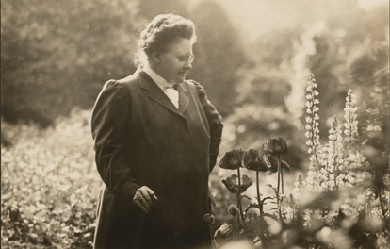
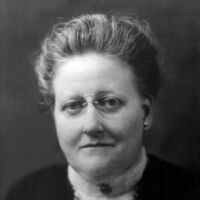
Amy Lawrence Lowell (February 9, 1874 – May 12, 1925) was an American poet of the imagist school from Brookline, Massachusetts, who posthumously won the Pulitzer Prize for Poetry in 1926. Amy was born into Brookline’s Lowell family, sister to astronomer Percival Lowell and Harvard president Abbott Lawrence Lowell. She never attended college because her family did not consider it proper for a woman to do so. She compensated for this lack with avid reading and near-obsessive book collecting. She lived as a socialite and travelled widely, turning to poetry in 1902 (age 28) after being inspired by a performance of Eleonora Duse in Europe.
Juan Antonio Alix. Desapercibido pasó el 180 aniversario del natalicio de Juan Antonio Alix (Moca, 6 septiembre 1833 – Santiago, 15 febrero 1918), recordado por sus décimas Eso e paja pa’ la gaiza, El follón de Yamasá, El negro tras de la oreja, Entre Lucas y Juan Mejía, Cánticos (mejor conocida como A las arandelas) y Los mangos bajitos. Sabemos que tenía una hermana, Carmen Alix Rodríguez, y que sus padres, Juan Mateo Alix, natural de Cabo Haitiano, y María Magdalena Rodríguez, casaron en Moca en 1829. Su madre, hija de Domingo Antonio Rodríguez y Juana de Rojas Valerio, había casado por primera vez con Juan José Espaillat Velilla, con quien había procreado a Juan Francisco, José María y Eloísa Espaillat Rodríguez, esta última esposa de su primo hermano paterno Ulises Francisco Espaillat Quiñones, presidente de la República en 1876. En su entorno familiar materno se descubren interesantes entronques. Una de sus tías fue Tomasina Rodríguez Rojas de Julia, ascendiente de los eminentes médicos Alejandro Llenas Julia y Arturo Grullón Julia, el gestor cultural Rafael Díaz Niese, el historiador mocano Julio Jaime Julia Guzmán, el historiador y político Juan Isidro Jimenes Grullón, el escritor Virgilio Díaz Grullón, el munícipe santiaguero Tomás (Jimmy) Pastoriza Espaillat y el banquero Alejandro Grullón Espaillat. Su tía abuela María Dolores Rojas Valerio de Solano fue madre, entre otros, de Domingo Antonio Solano Rojas, el famoso padre Solano, quien fuera padre, entre otros hijos, de Santiago Petitón y José Antonio Olavarrieta, troncos de las familias Petitón y Olavarrieta, y ascendiente del presidente Rafael Estrella Ureña, el Dr. José Jesús Jiménez Olavarrieta, Maestro de la Medicina Dominicana; el munícipe santiaguero Víctor Espaillat Mera y la ex primera dama Asela Mera de Jorge. De su lado, su tío abuelo Carlos de Rojas Valerio fue padre, entre otros, de Benigno Filomeno de Rojas Ramos, presidente del Congreso Constituyente que adoptó en Moca la Constitución de 1857 y prócer civil de la Guerra de la Restauración, y de Carlos de Rojas Ramos, tronco de la familia Rojas de Moca. Alix casó con Petronila Francisca Liriano Bidó y procreó a Petronila Hortensia (n.1868); Tomasina (f. 19 de marzo de 1940), esposa desde 1892 de José María Benedicto Luisón (papá Cheché), munícipe y presidente del Ayuntamiento de Santiago en varias ocasiones; Olivia Juana Antonia, quien casó con Agustín Bonilla Tavares en 1897; Rosalina (Rocha), quien casó en 1898 con Manuel Malagón Espaillat y fallecida en 1900 a la edad de 23 años; Carmen, fallecida soltera y sin descendencia, y Agripina (Pinona) Alix Liriano, esposa del puertorriqueño Ramón Goico. El matrimonio Benedicto Alix procreó a Graciela, esposa de Narciso Román; Mario, Mercedes, Migdalia, Rafael, Rosa Celia, cónyuge de Eladio Antonio Victoria Morales, y José Tomás Benedicto Alix, esposo de Delia Guzmán. Los hijos de Olivia Juana Antonia Alix de Bonilla, fueron Agustín, Betina, Carlos, Dorila, Emma, casada con Rafael Díaz Espinal; María, cónyuge de Manuel Furcy Bonnelly Fondeur; Nidia Antonia, cónyuge de José Manuel Nicolás Rodríguez, y Zaida Bonilla Alix. De su lado, los hijos de Agripina Alix Liriano fueron Mercedes, Miguel Ángel, Octavio y Juan Goico Alix, este último poeta como su abuelo. La descendencia de Alix alcanza ya la sexta generación, compuesta por niños y jóvenes nacidos a fines del siglo XX y principios del XXI, quienes de seguro desconocen que tienen “detrás de la oreja” a nuestro máximo poeta popular. Instituto Dominicano de Genealogía Referencias Hoy—hoy.com.do/juan-antonio-alix-180-anos/
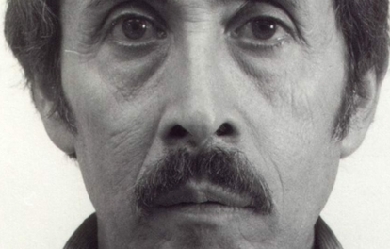

Jorge Eduardo Eielson (Lima, 13 de abril de 1924 - Milán, 8 de marzo de 2006) fue un poeta y artista peruano. Hijo de una ciudadana limeña y de un estadounidense de origen escandinavo. Cuando tenía siete años fallece su padre. Desde su juventud manifestó su inclinación hacia distintas formas de arte, incluyendo la literatura, las artes visuales y la música. En 1945 gana el Premio Nacional de Poesía con el poemario Reinos, publicado en la revista Historia dirigida por el historiador nacional Jorge Basadre. Al año siguiente obtiene el III Premio Nacional de Teatro 1948 por una obra titulada Maquillage, parcialmente publicada en la revista Espacio y recientemente publicada en su totalidad en libro. En simultáneo a sus primeros textos literarios realiza sus primeras obras gráficas, exponiendo algunas de estas junto a otros objetos en 1948. Ese año lleva a cabo un viaje a París gracias a una beca del gobierno francés, iniciando con ello una suerte de exilio voluntario de su país, al cual retornaría en muchas, aún cuando cortas oportunidades. Vivió la mayor parte del tiempo en Europa y se asentó en Milán (Italia). Su obra literaria se caracteriza por la búsqueda de la pureza en la expresión, procurando una forma que trascienda las limitaciones de la realidad y del lenguaje. Ello lo llevó a dedicarse además de a las letras, a las artes visuales, entregado a una experimentación vanguardista que le permite un diálogo inédito con algunos aspectos de la cultura precolombina peruana, y tomando particularmente como signo una versión propia del Quipu. Por su trabajo como artista recibió en el Perú el Premio Tecnoquímica en 2004. Al año siguiente participó en el proyecto de arte público Itinerarios del sonido, con una pieza que se presentaba en una parada de autobús en el Paseo del Pintor Rosales, en Madrid. El conjunto de su obra poética se ha editado tres veces con el título Poesía escrita, primero en Lima en 1976, luego México en el año 1989 y posteriormente en Colombia, en 1998. Además, en 2005 la Pontificia Universidad Católica del Perú elaboró una edición especial con toda su obra poética, sumada a selecciones de sus trabajos en prosa y reproducciones de su creación plástica. Junto con los poetas peruanos Blanca Varela, César Calvo, Antonio Cisneros y Luis Hernández, entre otros, es considerado el poeta peruano que mayor influencia ha dejado en el ámbito de la poesía latinoamericana. Poesía: * Reinos (1945) * Canción y muerte de Rolando (1959) * Mutatis mutandis (1967) * Poesía escrita (1976) * Poesía escrita, 2ª edición (1989) * Noche oscura del cuerpo (1989) * Antología (1996) * Nudos, ed. bilingüe (1997) * Poesía escrita, ed. de Martha Canfield (1998) * Sin título (2000) * Celebración (2001) * Canto visibile (2002) * Nudos (2002) * Arte poética, antología (2005) * Del absoluto amor y otros poemas sin título (2005) * De materia verbalis (2005) * Habitación en Roma, ed. de Martha Canfield (2008) * Pytx (2008) * Habitación en Roma, ed. de Sergio Téllez-Pon (Quimera, México, 2009) * Poeta en Roma (2009) Narrativa: * El cuerpo de Giulia-no (1971) * Primera muerte de María (2002) Teatro: * Acto final (1959) * Maquillage. [Obra en dos actos y un prólogo]. Edición y presentación de Ricardo Silva-Santisteban. Colofón de Jesús Cabel. Lima: Universidad Nacional San Luis Gonzaga – Editorial San Marcos, 2012. 62 pp. (Colección Huarango; 6). ISBN 978-612-302-747-6 [Obra ganadora del III Premio Nacional de Teatro 1948 y estrenada el 25 de mayo de 1950 en el teatro de la Asociación de Artistas Aficionados (AAA), bajo la dirección de Joaquín Roca Rey]. Referencias Wikipedia—http://es.wikipedia.org/wiki/Jorge_Eielson
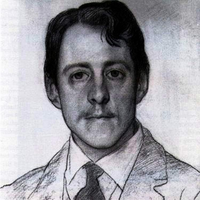
Robert Laurence Binyon, CH (10 August 1869– 10 March 1943) was an English poet, dramatist and art scholar. His most famous work, For the Fallen, is well known for being used in Remembrance Sunday services. Pre-war life Laurence Binyon was born in Lancaster, Lancashire, England. His parents were Frederick Binyon, and Mary Dockray. Mary’s father, Robert Benson Dockray, was the main engineer of the London and Birmingham Railway. The family were Quakers. Binyon studied at St Paul’s School, London. Then he read Classics (Honour Moderations) at Trinity College, Oxford, where he won the Newdigate Prize for poetry in 1891. Immediately after graduating in 1893, Binyon started working for the Department of Printed Books of the British Museum, writing catalogues for the museum and art monographs for himself. In 1895 his first book, Dutch Etchers of the Seventeenth Century, was published. In that same year, Binyon moved into the Museum’s Department of Prints and Drawings, under Campbell Dodgson. In 1909, Binyon became its Assistant Keeper, and in 1913 he was made the Keeper of the new Sub-Department of Oriental Prints and Drawings. Around this time he played a crucial role in the formation of Modernism in London by introducing young Imagist poets such as Ezra Pound, Richard Aldington and H.D. to East Asian visual art and literature. Many of Binyon’s books produced while at the Museum were influenced by his own sensibilities as a poet, although some are works of plain scholarship– such as his four-volume catalogue of all the Museum’s English drawings, and his seminal catalogue of Chinese and Japanese prints. In 1904 he married historian Cicely Margaret Powell, and the couple had three daughters. During those years, Binyon belonged to a circle of artists, as a regular patron of the Wiener Cafe of London. His fellow intellectuals there were Ezra Pound, Sir William Rothenstein, Walter Sickert, Charles Ricketts, Lucien Pissarro and Edmund Dulac. Binyon’s reputation before the war was such that, on the death of the Poet Laureate Alfred Austin in 1913, Binyon was among the names mentioned in the press as his likely successor (others named included Thomas Hardy, John Masefield and Rudyard Kipling; the post went to Robert Bridges). For the Fallen Moved by the opening of the Great War and the already high number of casualties of the British Expeditionary Force, in 1914 Laurence Binyon wrote his For the Fallen, with its Ode of Remembrance, as he was visiting the cliffs on the north Cornwall coast, either at Polzeath or at Portreath (at each of which places there is a plaque commemorating the event, though Binyon himself mentioned Polzeath in a 1939 interview. The confusion may be related to Porteath Farm being near Polzeath). The piece was published by The Times newspaper in September, when public feeling was affected by the recent Battle of Marne. Today Binyon’s most famous poem, For the Fallen, is often recited at Remembrance Sunday services in the UK; is an integral part of Anzac Day services in Australia and New Zealand and of the 11 November Remembrance Day services in Canada. The third and fourth verses of the poem (although often just the fourth) have thus been claimed as a tribute to all casualties of war, regardless of nation. They went with songs to the battle, they were young. Straight of limb, true of eyes, steady and aglow. They were staunch to the end against odds uncounted, They fell with their faces to the foe. They shall grow not old, as we that are left grow old: Age shall not weary them, nor the years condemn. At the going down of the sun and in the morning, We will remember them. They mingle not with their laughing comrades again; They sit no more at familiar tables of home; They have no lot in our labour of the day-time; They sleep beyond England’s foam Three of Binyon’s poems, including “For the Fallen”, were set by Sir Edward Elgar in his last major orchestra/choral work, The Spirit of England. In 1915, despite being too old to enlist in the First World War, Laurence Binyon volunteered at a British hospital for French soldiers, Hôpital Temporaire d’Arc-en-Barrois, Haute-Marne, France, working briefly as a hospital orderly. He returned in the summer of 1916 and took care of soldiers taken in from the Verdun battlefield. He wrote about his experiences in For Dauntless France (1918) and his poems, “Fetching the Wounded” and “The Distant Guns”, were inspired by his hospital service in Arc-en-Barrois. Artists Rifles, a CD audiobook published in 2004, includes a reading of For the Fallen by Binyon himself. The recording itself is undated and appeared on a 78 rpm disc issued in Japan. Other Great War poets heard on the CD include Siegfried Sassoon, Edmund Blunden, Robert Graves, David Jones and Edgell Rickword. Post-war life After the war, he returned to the British Museum and wrote numerous books on art; in particular on William Blake, Persian art, and Japanese art. His work on ancient Japanese and Chinese cultures offered strongly contextualised examples that inspired, among others, the poets Ezra Pound and W. B. Yeats. His work on Blake and his followers kept alive the then nearly-forgotten memory of the work of Samuel Palmer. Binyon’s duality of interests continued the traditional interest of British visionary Romanticism in the rich strangeness of Mediterranean and Oriental cultures. In 1931, his two volume Collected Poems appeared. In 1932, Binyon rose to be the Keeper of the Prints and Drawings Department, yet in 1933 he retired from the British Museum. He went to live in the country at Westridge Green, near Streatley (where his daughters also came to live during the Second World War). He continued writing poetry. In 1933–1934, Binyon was appointed Norton Professor of Poetry at Harvard University. He delivered a series of lectures on The Spirit of Man in Asian Art, which were published in 1935. Binyon continued his academic work: in May 1939 he gave the prestigious Romanes Lecture in Oxford on Art and Freedom, and in 1940 he was appointed the Byron Professor of English Literature at University of Athens. He worked there until forced to leave, narrowly escaping the German invasion of Greece in April 1941 . He was succeeded by Lord Dunsany, who held the chair in 1940-1941. Binyon had been friends with Ezra Pound since around 1909, and in the 1930s the two became especially close; Pound affectionately called him “BinBin”, and assisted Binyon with his translation of Dante. Another protégé was Arthur Waley, whom Binyon employed at the British Museum. Between 1933 and 1943, Binyon published his acclaimed translation of Dante’s Divine Comedy in an English version of terza rima, made with some editorial assistance by Ezra Pound. Its readership was dramatically increased when Paolo Milano selected it for the “The Portable Dante” in Viking’s Portable Library series. Binyon significantly revised his translation of all three parts for the project, and the volume went through three major editions and eight printings (while other volumes in the same series went out of print) before being replaced by the Mark Musa translation in 1981. At his death he was also working on a major three-part Arthurian trilogy, the first part of which was published after his death as The Madness of Merlin (1947). He died in Dunedin Nursing Home, Bath Road, Reading, on 10 March 1943 after an operation. A funeral service was held at Trinity College Chapel, Oxford, on 13 March 1943. There is a slate memorial in St. Mary’s Church, Aldworth, where Binyon’s ashes were scattered. On 11 November 1985, Binyon was among 16 Great War poets commemorated on a slate stone unveiled in Westminster Abbey’s Poets’ Corner. The inscription on the stone quotes a fellow Great War poet, Wilfred Owen. It reads: “My subject is War, and the pity of War. The Poetry is in the pity.” Daughters His three daughters Helen, Margaret and Nicolete became artists. Helen Binyon (1904–1979) studied with Paul Nash and Eric Ravilious, illustrating many books for the Oxford University Press, and was also a marionettist. She later taught puppetry and published Puppetry Today (1966) and Professional Puppetry in England (1973). Margaret Binyon wrote children’s books, which were illustrated by Helen. Nicolete, as Nicolete Gray, was a distinguished calligrapher and art scholar. Bibliography of key works Poems and verse * Lyric Poems (1894) * Porphyrion and other Poems (1898) * Odes (1901) * Death of Adam and Other Poems (1904) * London Visions (1908) * England and Other Poems (1909) * “For The Fallen”, The Times, 21 September 1914 * Winnowing Fan (1914) * The Anvil (1916) * The Cause (1917) * The New World: Poems (1918) * The Idols (1928) * Collected Poems Vol 1: London Visions, Narrative Poems, Translations. (1931) * Collected Poems Vol 2: Lyrical Poems. (1931) * The North Star and Other Poems (1941) * The Burning of the Leaves and Other Poems (1944) * The Madness of Merlin (1947) In 1915 Cyril Rootham set “For the Fallen” for chorus and orchestra, first performed in 1919 by the Cambridge University Musical Society conducted by the composer. Edward Elgar set to music three of Binyon’s poems ("The Fourth of August", “To Women”, and “For the Fallen”, published within the collection “The Winnowing Fan”) as The Spirit of England, Op. 80, for tenor or soprano solo, chorus and orchestra (1917). English arts and myth * Dutch Etchers of the Seventeenth Century (1895), Binyon’s first book on painting * John Crone and John Sell Cotman (1897) * William Blake: Being all his Woodcuts Photographically Reproduced in Facsimile (1902) * English Poetry in its relation to painting and the other arts (1918) * Drawings and Engravings of William Blake (1922) * Arthur: A Tragedy (1923) * The Followers of William Blake (1925) * The Engraved Designs of William Blake (1926) * Landscape in English Art and Poetry (1931) * English Watercolours (1933) * Gerard Hopkins and his influence (1939) * Art and freedom. (The Romanes lecture, delivered 25 May 1939). Oxford: The Clarendon press, (1939) Japanese and Persian arts * Painting in the Far East (1908) * Japanese Art (1909) * Flight of the Dragon (1911) * The Court Painters of the Grand Moguls (1921) * Japanese Colour Prints (1923) * The Poems of Nizami (1928) (Translation) * Persian Miniature Painting (1933) * The Spirit of Man in Asian Art (1936) Autobiography * For Dauntless France (1918) (War memoir) Biography * Botticelli (1913) * Akbar (1932) Stage plays * Brief Candles A verse-drama about the decision of Richard III to dispatch his two nephews * “Paris and Oenone”, 1906 * Godstow Nunnery: Play * Boadicea; A Play in eight Scenes * Attila: a Tragedy in Four Acts * Ayuli: a Play in three Acts and an Epilogue * Sophro the Wise: a Play for Children * (Most of the above were written for John Masefield’s theatre). * Charles Villiers Stanford wrote incidental music for Attila in 1907. References Wikipedia—https://en.wikipedia.org/wiki/Laurence_Binyon

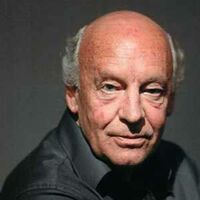
Eduardo Germán María Hughes Galeano (Montevideo, 3 de septiembre de 1940-Ib., 13 de abril de 2015) fue un periodista y escritor uruguayo, considerado uno de los escritores más influyentes de la izquierda latinoamericana. Sus libros más conocidos, Las venas abiertas de América Latina (1971) y Memoria del fuego (1986), han sido traducidos a veinte idiomas. Sus trabajos trascienden géneros ortodoxos y combinan documental, ficción, periodismo, análisis político e historia.

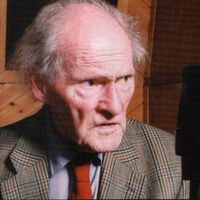
Ronald Stuart Thomas (29 March 1913 – 25 September 2000), published as R. S. Thomas, was a Welsh poet and Anglican priest who was noted for his nationalism, spirituality and deep dislike of the anglicisation of Wales. In 1955, John Betjeman, in his introduction to the first collection of Thomas’s poetry to be produced by a major publisher, Song at the Year's Turning, predicted that Thomas would be remembered long after Betjeman himself was forgotten. M. Wynn Thomas said: "He was the Aleksandr Solzhenitsyn of Wales because he was such a troubler of the Welsh conscience. He was one of the major English language and European poets of the 20th century." R. S. Thomas was born in Cardiff, the only child of Thomas Hubert and Margaret (née Davis). The family moved to Holyhead in 1918 because of his father's work in the merchant navy. He was awarded a bursary in 1932 to study at Bangor University, where he read Classics. In 1936, having completed his theological training at St. Michael's College, Llandaff, he was ordained as a priest in the Church in Wales. From 1936 to 1940 he was the curate of Chirk, Denbighshire, where he met his future wife, Mildred (Elsi) Eldridge, an English artist. He subsequently became curate at Tallarn Green, Flintshire. Thomas and Mildred were married in 1940 and remained together until her death in 1991. Their son, Gwydion, was born 29 August 1945. The Thomas family lived on a tiny income and lacked the comforts of modern life, largely by the Thomas's choice. One of the few household amenities the family ever owned, a vacuum cleaner, was rejected because Thomas decided it was too noisy. For twelve years, from 1942 to 1954, Thomas was rector at Manafon, near Welshpool in rural Montgomeryshire. It was during his time at Manafon that he first began to study Welsh and that he published his first three volumes of poetry, The Stones of the Field, An Acre of Land and The Minister. Thomas' poetry achieved a breakthrough with the publication of his fourth book Song at the Year's Turning, in effect a collected edition of his first three volumes, which was critically very well received and opened with Betjeman's famous introduction. His position was also helped by winning the Royal Society of Literature's Heinemann Award. Thomas learnt the Welsh language at age 30, too late in life, he said, to be able to write poetry in it. The 1960s saw him working in a predominantly Welsh speaking community and he later wrote two prose works in Welsh, Neb (English: Nobody), an ironic and revealing autobiography written in the third person, and Blwyddyn yn Llŷn (English: A Year in Llŷn). In 1964 he won the Queen's Gold Medal for Poetry. From 1967 to 1978 he was vicar at St Hywyn's Church (built 1137) in Aberdaron at the western tip of the Llŷn Peninsula. Thomas retired from church ministry in 1978 and he and his wife relocated to Y Rhiw, in "a tiny, unheated cottage in one of the most beautiful parts of Wales, where, however, the temperature sometimes dipped below freezing", according to Theodore Dalrymple. Free from the constraints of the church he was able to become more political and active in the campaigns that were important to him. He became a fierce advocate of Welsh nationalism, although he never supported Plaid Cymru because he believed they did not go far enough in their opposition to England. In 1996 Thomas was nominated for the Nobel Prize for Literature (the winner that year was Seamus Heaney). Thomas died on 25 September 2000, aged 87, at his home at Pentrefelin near Criccieth. He had been ill with heart trouble and had been treated at Gwynnedd hospital until two weeks before he died. After his death an event celebrating his life and poetry was held in Westminster Abbey with readings from Heaney, Andrew Motion, Gillian Clarke and John Burnside. Thomas's ashes are buried close to the door of St. John's Church, Porthmadog, Gwynedd. Beliefs Thomas believed in what he called "the true Wales of my imagination", a Welsh-speaking, aboriginal community that was in tune with the natural world. He viewed western (specifically English) materialism and greed, represented in the poetry by his mythical "Machine", as the destroyers of community. He could tolerate neither the English who bought up Wales and, in his view, stripped it of its wild and essential nature, nor the Welsh whom he saw as all too eager to kowtow to English money and influence. This may help explain why Thomas was an ardent supporter of CND and described himself as a pacifist but also why he supported the Meibion Glyndŵr fire-bombings of English-owned holiday cottages in rural Wales. On this subject he said in 1998, "what is one death against the death of the whole Welsh nation?" He was also active in wildlife preservation and worked with the RSPB and Welsh volunteer organisations for the preservation of the Red Kite. He resigned his RSPB membership over their plans to introduce non-native kites to Wales. Thomas's son, Gwydion, a resident of Thailand, recalls his father's sermons, in which he would "drone on" to absurd lengths about the evil of refrigerators, washing machines, televisions and other modern devices. Thomas preached that they were all part of the temptation of scrambling after gadgets rather than attending to more spiritual needs. "It was the Machine, you see", Gwydion Thomas explained to a biographer. "This to a congregation that didn’t have any of these things and were longing for them." Although he may have taken some ideas to extreme lengths, Theodore Dalrymple wrote, Thomas "was raising a deep and unanswered question: What is life for? Is it simply to consume more and more, and divert ourselves with ever more elaborate entertainments and gadgetry? What will this do to our souls?" Although he was a cleric, he was not always charitable and was known for being awkward and taciturn. Some critics have interpreted photographs of him as indicating he was "formidable, bad-tempered, and apparently humorless." Works Almost all of Thomas's work concerns the Welsh landscape and the Welsh people, themes with both political and spiritual subtext. His views on the position of the Welsh people, as a conquered people are never far below the surface. As a cleric, his religious views are also present in his works. His earlier works focus on the personal stories of his parishioners, the farm labourers and working men and their wives, challenging the cosy view of the traditional pastoral poem with harsh and vivid descriptions of rural lives. The beauty of the landscape, although ever-present, is never suggested as a compensation for the low pay or monotonous conditions of farm work. This direct view of "country life" comes as a challenge to many English writers writing on similar subjects and challenging the more pastoral works of such as contemporary poets as Dylan Thomas. Thomas's later works were of a more metaphysical nature, more experimental in their style and focusing more overtly on his spirituality. Laboratories of the Spirit (1975) gives, in its title, a hint at this development and also reveals Thomas's increasing experiments with scientific metaphor. He described this shift as an investigation into the "adult geometry of the mind".} Fearing that poetry was becoming a dying art, inaccessible to those who most needed it, "he attempted to make spiritually minded poems relevant within, and relevant to, a science-minded, post-industrial world", to represent that world both in form and in content even as he rejected its machinations. Despite his nationalism Thomas could be hard on his fellow countrymen. Often his works read as more of a criticism of Welshness than a celebration. He himself said there is a "lack of love for human beings" in his poetry. Other critics have not been so harsh. Al Alvarez said: "He was wonderful, very pure, very bitter but the bitterness was beautifully and very sparely rendered. He was completely authoritative, a very, very fine poet, completely off on his own, out of the loop but a real individual. It's not about being a major or minor poet. It's about getting a work absolutely right by your own standards and he did that wonderfully well." Thomas's final works commonly sold 20,000 copies in Britain alone. Books * The Stones of the Field (1946) * An Acre of Land (1952) * The Minister (1953) * Song at the Year's Turning (1955) * Poetry for Supper (1958) * Tares, [Corn-weed] (1961) * The Bread of Truth (1963) * Words and the Poet (1964, lecture) * Pietà (1966) * Not That He Brought Flowers (1968) * H'm (1972) * What is a Welshman? (1974) * Laboratories of the Spirit (1975) * Abercuawg (1976, lecture) * The Way of It (1977) * Frequencies (1978) * Between Here and Now (1981) * Ingrowing Thoughts (1985) * Neb (1985) in Welsh, autobiography, written in the third person * Experimenting with an Amen (1986) * Welsh Airs (1987) * The Echoes Return Slow (1988) * Counterpoint (1990) * Blwyddyn yn Llŷn (1990) in Welsh * Pe Medrwn Yr Iaith : ac ysgrifau eraill ed. Tony Brown & Bedwyr L. Jones, essays in Welsh (1990) * Mass for Hard Times (1992) * No Truce with the Furies (1995) * Autobiographies (1997, collection of prose writings) * Residues (2002, posthumously) References Wikipedia - http://en.wikipedia.org/wiki/R._S._Thomas
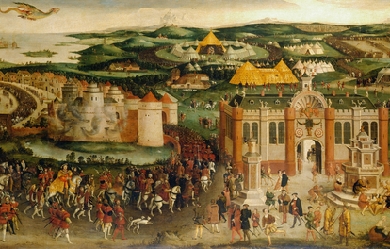
Edmund Spenser (c. 1552 – 13 January 1599) was an English poet best known for The Faerie Queene, an epic poem and fantastical allegory celebrating the Tudor dynasty and Elizabeth I. He is recognised as one of the premier craftsmen of Modern English verse in its infancy, and is considered one of the greatest poets in the English language. Edmund Spenser was born in East Smithfield, London, around the year 1552, though there is some ambiguity as to the exact date of his birth. As a young boy, he was educated in London at the Merchant Taylors' School and matriculated as a sizar at Pembroke College, Cambridge. While at Cambridge he became a friend of Gabriel Harvey and later consulted him, despite their differing views on poetry. In 1578 he became for a short time secretary to John Young, Bishop of Rochester. In 1579 he published The Shepheardes Calender and around the same time married his first wife, Machabyas Childe. In July 1580 Spenser went to Ireland in service of the newly appointed Lord Deputy, Arthur Grey, 14th Baron Grey de Wilton. When Grey was recalled to England, he stayed on in Ireland, having acquired other official posts and lands in the Munster Plantation. At some time between 1587 and 1589 he acquired his main estate at Kilcolman, near Doneraile in North Cork. Among his acquaintances in the area was Walter Raleigh, a fellow colonist. He later bought a second holding to the south, at Rennie, on a rock overlooking the river Blackwater in North Cork. Its ruins are still visible today. A short distance away grew a tree, locally known as "Spenser's Oak" until it was destroyed in a lightning strike in the 1960s. Local legend has it that he penned some of The Faerie Queene under this tree. In 1590 Spenser brought out the first three books of his most famous work, The Faerie Queene, having travelled to London to publish and promote the work, with the likely assistance of Raleigh. He was successful enough to obtain a life pension of £50 a year from the Queen. He probably hoped to secure a place at court through his poetry, but his next significant publication boldly antagonised the queen's principal secretary, Lord Burghley, through its inclusion of the satirical Mother Hubberd's Tale. He returned to Ireland. By 1594 Spenser's first wife had died, and in that year he married Elizabeth Boyle, to whom he addressed the sonnet sequence Amoretti. The marriage itself was celebrated in Epithalamion. In 1596 Spenser wrote a prose pamphlet titled, A View of the Present State of Ireland. This piece, in the form of a dialogue, circulated in manuscript, remaining unpublished until the mid-seventeenth century. It is probable that it was kept out of print during the author's lifetime because of its inflammatory content. The pamphlet argued that Ireland would never be totally 'pacified' by the English until its indigenous language and customs had been destroyed, if necessary by violence. Later on, during the Nine Years War in 1598, Spenser was driven from his home by the native Irish forces of Aodh Ó Néill. His castle at Kilcolman was burned, and Ben Jonson (who may have had private information) asserted that one of his infant children died in the blaze. In the year after being driven from his home, Spenser travelled to London, where he died aged forty-six. His coffin was carried to his grave in Westminster Abbey by other poets, who threw many pens and pieces of poetry into his grave with many tears. His second wife survived him and remarried twice. Rhyme and reason Thomas Fuller included in his Worthies of England a story that The Queen told her treasurer, William Cecil, to pay Spenser one hundred pounds for his poetry. The treasurer, however, objected that the sum was too much. She said, "Then give him what is reason". After a long while without receiving his payment, Spenser gave the Queen this quatrain on one of her progresses: I was promis'd on a time, To have a reason for my rhyme: From that time unto this season, I receiv'd nor rhyme nor reason. She immediately ordered the treasurer pay Spenser the original £100. This story seems to have attached itself to Spenser from Thomas Churchyard, who apparently had difficulty in getting payment of his pension (the only other one Elizabeth awarded to a poet). Spenser seems to have had no difficulty in receiving payment when it was due, the pension being collected for him by his publisher, Ponsonby. The Faerie Queene Spenser's masterpiece is the epic poem The Faerie Queene. The first three books of The Faerie Queene were published in 1590, and a second set of three books were published in 1596. Spenser originally indicated that he intended the poem to consist of twelve books, so the version of the poem we have today is incomplete. Despite this, it remains one of the longest poems in the English language. It is an allegorical work, and can be read (as Spenser presumably intended) on several levels of allegory, including as praise of Queen Elizabeth I. In a completely allegorical context, the poem follows several knights in an examination of several virtues. In Spenser's "A Letter of the Authors," he states that the entire epic poem is "cloudily enwrapped in allegorical devises," and that the aim behind The Faerie Queene was to “fashion a gentleman or noble person in virtuous and gentle discipline.” Shorter poems Spenser published numerous relatively short poems in the last decade of the sixteenth century, almost all of which consider love or sorrow. In 1591 he published Complaints, a collection of poems that express complaints in mournful or mocking tones. Four years later, in 1595, Spenser published Amoretti and Epithalamion. This volume contains eighty-nine sonnets commemorating his courtship of Elizabeth Boyle. In “Amoretti,” Spenser uses subtle humour and parody while praising his beloved, reworking Petrarchism in his treatment of longing for a woman. “Epithalamion,” similar to “Amoretti,” deals in part with the unease in the development of a romantic and sexual relationship. It was written for his wedding to his young bride, Elizabeth Boyle. The poem consists of 365 long lines, corresponding to the days of the year; 68 short lines, claimed to represent the sum of the 52 weeks, 12 months, and 4 seasons of the annual cycle; and 24 stanzas, corresponding to the diurnal and sidereal hours.[citation needed] Some have speculated that the attention to disquiet in general reflects Spenser’s personal anxieties at the time, as he was unable to complete his most significant work, The Faerie Queene. In the following year Spenser released "Prothalamion," a wedding song written for the daughters of a duke, allegedly in hopes to gain favor in the court. The Spenserian stanza and sonnet Spenser used a distinctive verse form, called the Spenserian stanza, in several works, including The Faerie Queene. The stanza's main meter is iambic pentameter with a final line in iambic hexameter (having six feet or stresses, known as an Alexandrine), and the rhyme scheme is ababbcbcc. He also used his own rhyme scheme for the sonnet. Influences and influenced Though Spenser was well read in classical literature, scholars have noted that his poetry does not rehash tradition, but rather is distinctly his. This individuality may have resulted, to some extent, from a lack of comprehension of the classics. Spenser strove to emulate such ancient Roman poets as Virgil and Ovid, whom he studied during his schooling, but many of his best-known works are notably divergent from those of his predecessors.[15] The language of his poetry is purposely archaic, reminiscent of earlier works such as The Canterbury Tales of Geoffrey Chaucer and Il Canzoniere of Francesco Petrarca, whom Spenser greatly admired. Spenser was called a Poets' Poet and was admired by William Wordsworth, John Keats, Lord Byron, and Alfred Lord Tennyson, among others. Walter Raleigh wrote a dedicatory sonnet to The Faerie Queene in 1590, in which he claims to admire and value Spenser’s work more so than any other in the English language. In the eighteenth century, Alexander Pope compared Spenser to “a mistress, whose faults we see, but love her with them all." A View of the Present State of Ireland n his work A View of the present State of Ireland, Spenser devises his ideas to the issues of the nation of Ireland. These views are suspected to not be his own but based on the work of his predecessor, Lord Arthur Grey de Wilton who was appointed Lord Deputy of Ireland in 1580 (Henley 19, 168-69). Lord Grey was a major figure in Ireland at the time and Spenser was influenced greatly by his ideals and his work in the country, as well as that of his fellow countrymen also living in Ireland at the time (Henley 169). The goal of this piece was to show that Ireland was in great need of reform. Spenser believed that “Ireland is a diseased portion of the State, it must first be cured and reformed, before it could be in a position to appreciate the good sound laws and blessings of the nation” (Henley 178). In A View of the present State of Ireland, Spenser categorizes the “evils” of the Irish people into three prominent categories: laws, customs, and religion (Spenser). These three elements work together in creating the disruptive and degraded people. One example given in the work is the native law system called “Brehon Law” which trumps the established law given by the English monarchy (Spenser). This system has its own court and way of dealing with infractions. It has been passed down through the generations and Spenser views this system as a native backward custom which must be destroyed. Spenser also recommended scorched earth tactics, such as he had seen used in the Desmond Rebellions, to create famine. Although it has been highly regarded as a polemical piece of prose and valued as a historical source on 16th century Ireland, the View is seen today as genocidal in intent. Spenser did express some praise for the Gaelic poetic tradition, but also used much tendentious and bogus analysis to demonstrate that the Irish were descended from barbarian Scythian stock. References Wikipedia - http://en.wikipedia.org/wiki/Edmund_Spenser
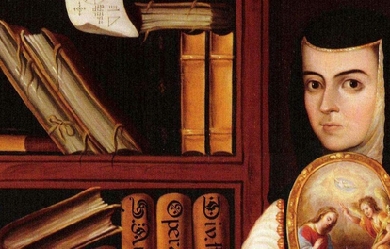
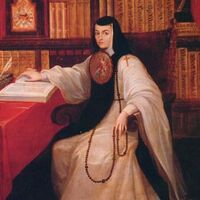
Juana Inés de Asbaje y Ramírez de Santillana, más conocida como Sor Juana Inés de la Cruz, (San Miguel Nepantla, 12 de noviembre de 1651—Ciudad de México, 17 de abril de 1695) fue una religiosa y escritora novohispana del Barroco en el Siglo de Oro. Cultivó la lírica, el auto sacramental y el teatro, así como la prosa. Por la importancia de su obra, recibió los sobrenombres de «el fénix de América», «la Décima Musa» o «la Décima Musa mexicana». A muy temprana edad aprendió a leer y a escribir. Perteneció a la corte de Antonio de Toledo y Salazar, marqués de Mancera y 25° virrey novohispano. En 1667 ingresó a la vida religiosa a fin de consagrarse por completo a la literatura. Sus más importantes mecenas fueron los marqueses de la Laguna, virreyes de la Nueva España, quienes publicaron sus obras en la España peninsular. Murió a causa de una epidemia el 17 de abril de 1695.
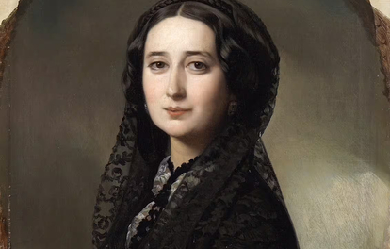
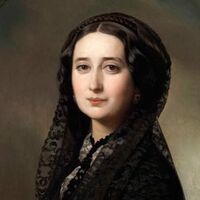
Carolina Coronado Romero de Tejada (Almendralejo, Badajoz, 12 de diciembre de 1820 - Lisboa, 15 de enero de 1911, enterrada en el Cementerio de Badajoz), escritora española, considerada como la equivalente extremeña de otras autoras románticas coetáneas como Rosalía de Castro, y autora de tal notoriedad que llegaría a ser calificada con el título de "El Bécquer femenino". Fue tía de Ramón Gómez de la Serna. Nació en el seno de una familia acomodada de Almendralejo (Badajoz), pero de ideología progresista, lo que provocó que su padre y su abuelo fueran perseguidos. Tras mudarse a la capital de provincia, Badajoz, Carolina sería educada de la forma tradicional para las niñas de la época: costura, labores del hogar... pese a lo cual, ya desde pequeña mostró su interés por la literatura, y comienza a leer, robando horas al sueño, cualquier género u obra que puede conseguir.
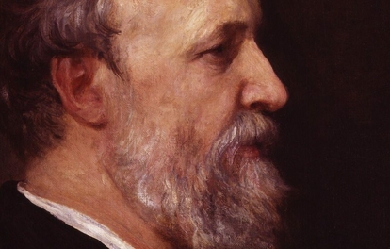
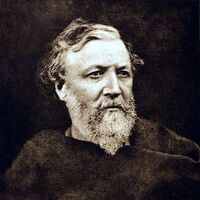
Robert Browning was born on May 7, 1812, in Camberwell, England. His mother was an accomplished pianist and a devout evangelical Christian. His father, who worked as a bank clerk, was also an artist, scholar, antiquarian, and collector of books and pictures. His rare book collection of more than 6,000 volumes included works in Greek, Hebrew, Latin, French, Italian, and Spanish. Much of Browning's education came from his well-read father. It is believed that he was already proficient at reading and writing by the age of five. A bright and anxious student, Browning learned Latin, Greek, and French by the time he was fourteen. From fourteen to sixteen he was educated at home, attended to by various tutors in music, drawing, dancing, and horsemanship.
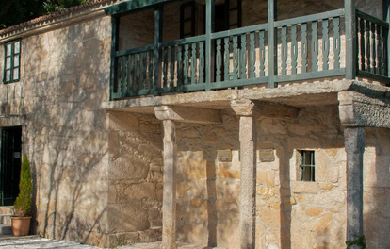
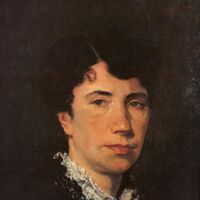
Rosalía de Castro (Santiago de Compostela, 24 de febrero de 1837 — Padrón, 15 de julio de 1885) fue una poetisa y novelista española que escribió tanto en lengua gallega como en lengua española. Considerada en la actualidad como un ente indispensable en el panorama literario del siglo XIX, representa junto con Eduardo Pondal y Curros Enríquez una de las figuras emblemáticas del Rexurdimento gallego, no sólo por su aportación literaria en general y por el hecho de que sus Cantares Gallegos sean entendidos como la primera gran obra de la literatura gallega contemporánea, sino por el proceso de sacralización al que fue sometida y que acabó por convertirla en encarnación y símbolo del pueblo gallego. Además, es considerada junto con Gustavo Adolfo Bécquer, como la precursora de la poesía española moderna. Escribir en gallego en el siglo XIX, es decir, en la época en la que vivió Rosalía, no resultaba nada fácil por un gran número de razones, la gran parte de ellas ligadas al pensamiento y estructuración de la sociedad del momento. La lengua gallega había quedado reducida a un mero dialecto, tan despreciado como desprestigiado, mostrándose cada vez más distante aquella época en la que había sido el idioma vehicular de la creación de lírica galaicoportuguesa (en forma de galaicoportugués). Toda la tradición escrita había sido perdida, por lo que se hacía necesario comenzar desde cero rompiendo con el sentimiento de desprecio e indiferencia hacia la lengua gallega, pero pocos eran los que se planteaban la tarea, pues esta constituiría un motivo de desprestigio social. En un ambiente en el castellano era la lengua de la cultura al ser la lengua que la clase minoritaria dominante protegía, Rosalía de Castro rompió a cantar, concediéndole el prestigio merecido al gallego al usarlo como vehículo de su obra denominada Cantares Gallegos y afianzando el renacer cultural de la lengua. Aunque fue una asidua cultivadora de la prosa, donde Rosalía sobresalió fue en el campo de la poesía, a través de la creación de las que pueden ser consideradas sus tres obras clave: Cantares Gallegos, Follas Novas y En las orillas del Sar. La primera de ellas representa un canto colectivo, artísticamente logrado, que sirvió de espejo dignificante a la comunidad gallega al emplearse la lengua de ésta, así como también fue útil para proseguir con la tendencia tímidamente iniciada por el pontevedrés Xoán Manuel Pintos con su obra titulada A Gaita Galega (1853). En la segunda, la escritora dio lugar a una poética de gran profundidad, que emplea el símbolo como método para expresar lo inefable y que revela la plurisignificación propia de la más elevada poesía; junto con las obras Aires da miña terra (Curros Enríquez), Saudades Gallegas (Valentín Lamas Carvajal) y Maxina ou a filla espúrea (Marcial Valladares Núñez) completa el conjunto de obras publicadas en la década de 1880 que hicieron de estos años una etapa clave en el desarrollo de la literatura gallega, si bien la obra de Rosalía siempre mantuvo una posición predominante con respecto al resto. Finalmente, en En las orillas del Sar se manifiesta un tono trágico que encaja con las duras circunstancias que rodearon los últimos años de la vida de Rosalía. Escrito en castellano, la obra ahonda en el lirismo subjetivo propio de Follas Novas al mismo tiempo que se consolidan las formas métricas que allí apuntaban. Inicialmente calificado de precursor y obviado por la crítica de su tiempo, hoy en día existen diferentes estudiosos que lo consideran como la principal creación poética de todo el siglo XIX. En la actualidad, la figura de Rosalía de Castro y sus creaciones literarias continúan siendo objeto de una abundante bibliografía y recibiendo una constante atención crítica, tanto en el territorio español como en el extranjero.4 Es tal la aceptación y el interés que las obras de esta escritora despiertan en el mundo, que en las últimas décadas sus poemas han sido traducidos a idiomas como el francés, el alemán, el ruso y el japonés. Infancia y juventud Nació en la madrugada del 24 de febrero de 1837 en una casa localizada en el margen derecho del Camiño Novo, la antigua vía de entrada a la ciudad de Santiago de Compostela para todos aquellos viajeros procedentes de Pontevedra. Hija natural del sacerdote José Martínez Viojo (1798 - 1871) y María Teresa de la Cruz Castro y Abadía (1804 - 1862), una hidalga soltera de escasos recursos económicos, fue bautizada a las pocas horas de su nacimiento en la Capilla del Hospital Real por el presbítero José Vicente Varela y Montero, con los nombres de María Rosalía Rita y figurando como hija de padres desconocidos. Con frecuencia, los biógrafos de la escritora gallega han ocultado la condición eclesiástica de su padre, así como también trataron de obviar el hecho de que fue registrada como hija de padres desconocidos y que se libró de entrar en la Inclusa al hacerse cargo de ella su madrina María Francisca Martínez, fiel sirviente de la madre de la recién nacida. «En veinte y cuatro de febrero de mil ochocientos treinta y seis, María Francisca Martínez, vecina de San Juan del Campo, fue madrina de una niña que bauticé solemnemente y puse los santos óleos, llamándole María Rosalía Rita, hija de padres incógnitos, cuya niña llevó la madrina, y va sin número por no haber pasado a la Inclusa; y para que así conste, lo firmo.» Acta del bautizo firmada por el presbítero José Vicente Varela y Montero. Hasta cumplir los ocho años, Rosalía se encontró bajo la custodia de su tía paterna Teresa Martínez Viojo en la aldea de Castro de Ortoño, perteneciente al municipio coruñés de Ames. Es en esta época cuando la escritora toma conciencia de la dureza de la vida del labriego gallego, así como también será en esta parte de su vida cuando tenga conocimiento y vivencia del mundo rural propio de Galicia: la lengua, las costumbres, las creencias o las cantigas que tanto influyeron en su obra titulada Cantares Gallegos. Si bien no se conoce con exactitud la fecha en que la madre de Rosalía decide hacerse cargo de ella, se sabe que en torno al año 1850 la joven se traslada a la ciudad de Santiago de Compostela donde vivió junto a esta, aunque ya había convivido con anterioridad con ella en Padrón.Nota 1 Es en esta localidad gallega donde Rosalía recibió la instrucción que por aquel entonces era la más adecuada para una señorita (nociones básicas de dibujo y música), asistiendo de forma habitual a las actividades culturales promovidas por el Liceo de la Juventud junto con personalidades destacadas de la mocedad intelectual compostelana como Manuel Murguía (se duda si fue en este momento cuando conoce a Murguía o posteriormente, en su traslado a Madrid), Eduardo Pondal y Aurelio Aguirre. Todavía en la actualidad es motivo de discusión entre los diferentes críticos la relación que Rosalía mantuvo con Aurelio Aguirre, puesto que a pesar de que se desconoce si existió una relación sentimental entre ambos, la obra del mencionado sí que dejó huella en ciertos poemas de la escritora. Madurez En abril de 1856, Rosalía se trasladó a Madrid junto con la familia de su parienta María Josefa Carmen García-Lugín y Castro, en cuya compañía habitó la planta baja de la casa número 13 de la calle Ballesta. No se conoce con exactitud cuál fue el motivo que llevó a mudarse a la escritora, aunque Catherine Davis creyó posible que este hecho fuese debido al escándalo desencadenado a raíz del Banquete de Conxo, en el que desenvolvieron un papel relevante varios miembros del Liceo, como fueron Aguirre o Pondal. Un año después de llegar a Madrid, Rosalía publicó un folleto de poesías escrito en lengua castellana que recibió el título de La flor, siendo este acogido con simpatía por parte de Manuel Murguía, quien hizo referencia a él en La Iberia. Posiblemente fue en Madrid, y no en el Liceo, donde Rosalía conoció a Murguía, con quien contrajo matrimonio el 10 de octubre de 1858 en la iglesia parroquial de San Ildefonso. Fue un amigo común el que posibilitó que ambos entablasen una relación que finalmente acabó en boda. Respecto de la relación que existió entre la pareja la crítica rosaliana sugiere diversas hipótesis, que van desde idílicos cuadros conyugales hasta posturas más que matizadas, que tomando como referencia escritos atribuidos a la poetisa, dibujan la psicología de una mujer solitaria, carente de felicidad y escéptica ante el amor. Sin embargo, Murguía fue la primera de las personas que animó a Rosalía en su quehacer literario, siendo él el responsable de la publicación de Cantares Gallegos. Tampoco le escatimó ni apoyo social ni intelectual en una época en la que la condición femenina era considerada como minusválida. Al año siguiente de casarse, Rosalía dio a luz en Santiago de Compostela a su primera hija, llamada Alejandra. A esta siguieron Aura (1862), que vino al mundo en el mismo año que feneció la madre de Rosalía; los gemelos Gala y Ovidio (1871); Amara (1873); Adriano Honorato (1875), que falleció a los diecinueve meses al precipitarse desde una mesa, y Valentina (1877), que nació muerta. Todos los hijos de Rosalía de Castro nacieron en Galicia, ya fuese en Lestrove, A Coruña o Santiago de Compostela. El domicilio del matrimonio cambió en múltiples ocasiones, a lo que se añadió una separación del mismo a causa de las actividades profesionales de Murguía y graves problemas económicos derivados tanto de la inestabilidad laboral del mismo como de la parca salud de Rosalía. Todos estos factores configuran un panorama vital que contribuye a explicar la hipersensibilidad y el pesimismo de la escritora. En 1859, el matrimonio estaba residiendo en La Coruña. Luego pasa a Madrid, de donde Rosalía regresa a Santiago (1861) para volver a la capital española. Con posterioridad, existen referencias que permiten afirmar la presencia de la poetisa en Lugo y Santiago, además de algunos viajes que realizó el matrimonio a Extremadura, Andalucía, Castilla La Mancha y Levante. En el mes de septiembre de 1868 se produjo el levantamiento revolucionario español, conocido como La Gloriosa, pasando Murguía de ser secretario de la Junta de Santiago a director del Archivo de Simancas, cargo que ejerció durante dos años. A partir de este momento, la vida de Rosalía se desenvolvió entre Madrid y Simancas, siendo en la ciudad vallisoletana en la que escribió gran parte de las composiciones recogidas en Follas Novas. Es conveniente aclarar que en estos mismos años, es cuando se produjo el encuentro entre Rosalía de Castro y Gustavo Adolfo Bécquer. Desde 1871, Rosalía no sale de Galicia. Vivió a partir de este año en las Torres de Lestrove (donde residían sus parientes los Hermida de Castro), en Dodro (La Coruña), en Santiago de Compostela y Padrón, donde prácticamente se instala en 1875. Últimos años Los últimos años de la vida de Rosalía transcurrieron en la comarca de Padrón, lugar en el que se había consumido su infancia, así como buena parte de su juventud. La Casa grande de Arretén, nombre popular con que el que se conocía al pazo en el que había nacido su progenitora, ya no era de la propiedad de la familia, factor que propició que la escritora tuviese que residir en las Torres de Lestrove entre 1879 y 1882 mientras su marido se encargaba de la dirección en Madrid de La Ilustración Gallega y Asturiana. Finalmente, se trasladó junto con su familia a la casa llamada de La Matanza, situada en la parroquia de Iria. Rosalía nunca disfrutó de una buena salud, pareciendo predestinada desde su juventud a una muerte temprana. De hecho, en las pocas cartas que se conservan y que ésta envió a su marido, con frecuencia se alude a las continuas dolencias que la atenazaban. Poco tiempo antes de fallecer, la escritora decidió pasar una temporada a las orillas del mar y por ello se trasladó a Santiago de Carril. Cierto tiempo después regresó al lugar de La Matanza, donde el cáncer de útero que padecía se fue complicando progresivamente desde 1883, mermando cada vez más a la ya de por sí débil salud de la escritora.Nota 2 Tras tres días de agonía falleció al mediodía del miércoles 15 de julio de 1885, en su casa de La Matanza, a consecuencia de una degeneración cancerosa del útero. El cuerpo inánime recibió sepultura al día siguiente en el cementerio de Adina, localizado en Iria Flavia, que curiosamente había sido cantado en una composición de Rosalía de Castro. No obstante, su cadáver fue exhumando el 15 de mayo de 1891 para ser llevado solemnemente a Santiago de Compostela, donde fue nuevamente sepultado en el mausoleo creado específicamente para la escritora por el escultor Jesús Landeira, situado en la capilla de la Visitación del Convento de Santo Domingo de Bonaval, en el presente Panteón de Galegos Ilustres. Resultan especialmente ilustrativas las fidedignas líneas escritas por González Besada sobre los últimos momentos de Rosalía: «...recibió con fervor los Santos Sacramentos, recitando en voz baja sus predilectas oraciones. Encargó a sus hijos quemasen los trabajos literarios que, ordenados y reunidos por ella misma, dejaba sin publicar. Dispuso se la enterrara en el cementerio de Adina, y pidiendo un ramo de pensamientos, la flor de su predilección, no bien se lo acercó a los labios sufrió un ahogo que fue comienzo de su agonía. Delirante, y nublada la vista, dijo a su hija Alejandra: "abre esa ventana que quiero ver el mar", y cerrando sus ojos para siempre, expiró...». Sin embargo, desde Padrón es imposible ver el mar. Por ello resultan enigmáticas estas palabras puestas en boca de una persona para quién el mar fue una perenne tentación de suicidio. Cantares Gallegos Fue en 1863 cuando Manuel Murguía hizo entrega al impresor vigués Juan Compañel del manuscrito rosaliano de Cantares Gallegos, obra iniciadora del Rexurdimento pleno. Para comprender el origen de ésta, hay que tener presentes factores tales como la familiaridad de la poetisa con la música popular, la reivindicación romántica de las culturas tradicionales y de sus manifestaciones populares. Tal fue el éxito alcanzado por la obra que Rosalía de Castro fue invitada a participar en los Juegos Florales de Barcelona, aunque declinó el ofrecimiento. Además, escritores lusos de la generación de 1865, como son Antero de Quental o Teófilo Braga,manifestaron con prontitud su admiración por el libro, para en 1868 ser vertidos al catalán dos de los poemas de éste por parte de Víctor Balaguer. Estructura y voces El libro está enmarcado entre los poemas uno y treinta y seis, siendo prólogo y epílogo respectivamente. Además manifiesta una estructura circular al iniciarse con una composición en la que toma la voz una joven a quién convidan a cantar y al finalizar con la misma voz de la muchacha que se disculpa por su falta de habilidad para cantar las bellezas de Galicia. De este modo, los poemas restantes quedan enmarcados por los que abren y cierran el discurso lírico y transformándose en una recreación de la artista popular que canta personalmente variopintos motivos, aunque en ciertos momentos le cede la voz a determinados tipos populares o incluso permite que en dos poemas hable la misma autora, concretamente en el número 25 y 33. En estos se hace evidente un yo lírico que puede entenderse como un método que Rosalía emplea con la intención de aparecer como un personaje popular más, dejándose patente su pertenencia a la comunidad rural. Temática En Cantares gallegos se encuentran recogidos cuatro núcleos temáticos fundamentales, que son el costumbrismo, el amor, el intimismo y en último lugar, el social-patriotismo. * Temática costumbrista: en un considerable número de composiciones predomina la descripción y la narración para presentar creencias, romerías, devociones o personajes característicos de la cultura popular gallega que Rosalía defendía frente a los estereotipos colonizadores. * Temática socio-patriótica: en este núcleo temático se engloban aquellas composiciones en las que la emigración, el abandono al que Galicia está condenada y la explotación de los gallegos en tierras extranjeras son los motivos a los que se recurre para criticar la situación de un pueblo gallego maltratado y reivindicar unos valores universales de justicia social. * Temática amorosa: Estos poemas nos muestran, desde una óptica popular, la manera de vivir el sentimiento amoroso diferentes personajes del pueblo en distintas circunstancias y situaciones. * Tematica intimista: Se incluyen aquí "Campanas de Bastabales" y "Como chove miúdiño". La voz de la propia autora expresa sus sentimientos. Follas novas En 1880, Rosalía de Castro editó en la capital española el que fue su segundo y último libro de versos en lengua gallega, titulado Follas novas. Muchos de los poemas que componen el libro fueron redactados durante la estancia de la familia en Simancas (1869 - 1870), aunque también existen algunas creaciones literarias que datan de la década de 1870 y que antes de aparecer en el libro ya habían sido publicados en la prensa. El poemario se halla dividido en cinco partes (Vaguedás, Do íntimo, Varia, Da terra e As viuvas dos vivos e as viuvas dos mortos) de extensión variable y que no responden a una planificación previa, sino a una ordenación posterior a la elaboración de los textos. Calificada como la obra más rica y profunda de Rosalía, Follas novas fue y sigue siendo considerada por buena parte de la crítica como el libro de transición entre la poesía colectiva de Cantares gallegos y el radical intimismo de En las orillas del Sar, en el que se da cabida a poemas de corte popular hasta creaciones que tratan el paso del tiempo y la muerte. También se caracteriza por ser una obra que tiene como trasfondo una notable intención social, que se manifiesta en la denuncia que la autora hace de la marginación del sexo femenino, de los niños huérfanos y de los campesinos, especialmente de aquellos que se habían visto en la obligación de emigrar ante las pésimas expectativas económicas del país. Estructura y núcleos temáticos El libro se abre con una dedicatoria de la autora a la Sociedade de beneficiencia dos naturales de Galicia en La Habana, de la que había sido nombrada socia honoraria. A continuación aparece el prólogo de Emilio Castelar, al que sigue un significativo preámbulo de la escritora (titulado Dúas palabras da autora), en el que se explica la característica cohesión existente entre lo personal y lo social, entre los sufrimientos íntimos y las desgracias colectivas, que constituye el eje central del poemario. En este preámbulo, Rosalía pone de manifiesto su intención de no volver a escribir en gallego (cosa que reitera en una carta escrita a Murguía en julio de 1881). Alá van, pois, as Follas novas, que mellor se dirían vellas, porque o son, e últimas, porque pagada xa a deuda en que me parecía estar coa miña terra, difícil é que volva a escribir máis versos na lengua materna. Los núcleos temáticos básicos de Follas novas son dos: por un lado se diferencia un tipo de poesía subjetiva, que se corresponde con los dos primeros apartados en que se estructura el libro (Vaguidades y Do íntimo), donde la autora desenvuelve un discurso existencial pesimista y angustiado. Por otro lado existe una poesía objetiva, correspondiente a los apartados cuarto y quinto (Da terra y As viúvas dos vivos e as viúvas dos mortos), en la que se insiste en el aspecto reivindicativo de lo popular y del hombre gallego, y donde se tratan temas que ya aparecieran en Cantares gallegos, como la emigración y la injusticia social. En el apartado tercero (Varia) coexisten trazas de la poesía objetiva y la subjetiva enseñando el complejo carácter que ofrece la realidad en toda su extensión para servir de puente entre la subjetividad de Do íntimo y la objetividad de Da terra. La concepción de la vida La obra poética, en la que el sentimiento constante y predominante es la saudade, nos ofrece una visión desolada del mundo y de la vida. También es reseñable la profundización en el yo que realiza la poetisa y que la lleva al descubrimiento de una saudade ontológica, un sentimiento misterioso e inefable de soledad sin relación con algo concreto, que esta vinculado a la radical orfandad del ser humano. Esta tara existencial que Rosalía analiza desde su propia vivencia, se percibe como el hallazgo final de un proceso en el que la desgracia va marcando su vida por medio del sufrimiento y del dolor, siendo éste último inevitable, como nos lo revela en el poema Unha vez tiven un cravo. Ante esta situación, la única solución es la huida o pérdida absoluta de la conciencia. Toda la visión desolada de la vida se intensifica con la angustia existencial que se deriva de la omnipresencia de un fantasma que atenaza su vida y que se manifiesta de forma especial en el símbolo oscuro, vago y polisémico de la negra sombra. En las orillas del Sar Un año antes del fallecimiento de Rosalía, ésta publicó el que resultó ser su último libro de poemas, titulado En las orillas del Sar escrito íntegramente en lengua castellana. Aún no hay consenso entre la crítica literaria con respecto a la fecha en la que fueron creados los poemas recogidos en este libro. Sin embargo, las palabras de González Besada en su discurso de ingreso a la Real Academia Española marcaron a la crítica posterior, pues según el periódico El Progreso de Pontevedra, afirmaba que las creaciones ahora recogidas "En las orillas del Sar" han visto la luz pública en 1866. Por el momento han sido infructuosas todas las búsquedas del susodicho periódico, por lo que tampoco se puede afirmar que en él se encontrasen plasmadas las poesías rosalianas. Compendio de obras prosísticas * Lieders (en lengua castellana, año 1858): este artículo publicado en El Álbum del Miño (Vigo) constituye el primer escrito en prosa en lengua castellana publicado por Rosalía de Castro, posiblemente como consecuencia de los comentarios favorables de Manuel Murguía y Benito Vicetto con respecto a su introducción en el ámbito poético. * La hija del mar (en lengua castellana, año 1859): su permanencia en Muxía le inspiró la * ambientación de esta obra en prosa,9 que además fue la primera de las novelas de Rosalía. En ella se desenvuelve el tema del temperamento femenino, tratándose de un relato de marcado carácter reivindicativo en el que dos mujeres intentan defender su honra en medio de un ambiente predominantemente femenino. * Flavio (en lengua castellana, año 1861): en esta obra aparece por primera vez el tema del amor desengañado, siendo recurrente en la poesía que cultivó a partir de este momento. Se trata de una novela de la etapa de la juventud de la autora, quién la define como un «ensayo de novela». * El caballero de las botas azules (en lengua castellana, año 1867): considerada por la crítica la más interesante de las novelas de Rosalía y calificada por ésta como un «cuento extraño», constituye una enigmática fantasía satírica en la que la escritora gallega expone un surtido de relatos de corte lírico-fantástico con trazos costumbristas que tiene el objetivo de satirizar tanto la hipocresía como la ignorancia de la sociedad madrileña. Confluyen en su composición elementos provenientes de dos campos, como son la libre imaginación (influencia de E. T. A. Hoffmann) y la sátira realista de costumbres. Hay en Madrid un palacio extenso y magnífico, como los que en otro tiempo levantaba el diablo para encantar a las damas hermosas y andantes caballeros. Vense en él habitaciones que por su elegante coquetería pudieran llamarse nidos de amor, y salones grandes como plazas públicas cuya austera belleza hiela de espanto el corazón y hace crispar los cabellos. Todo allí es agradable y artístico, todo impresiona de una manera extraña produciendo en el ánimo efectos mágicos que no se olvidan jamás. Fragmento del capítulo I de la novela El caballero de las botas azules * Conto gallego (en lengua gallega, año 1864): apareció por primera vez en una publicación periódica en el año 1864, y hasta el descubrimiento de esta edición sólo se tenía conocimiento de la publicación realizada por Manuel de Castro y López en su Almanaque gallego de Buenos Aires, en el año 1923.10 El cuento refiere un motivo tradicional de la literatura misógina en la que dos amigos hacen una apuesta con la intención de demostrar cual de ellos logra seducir a la viúda el mismo día del entierro de su marido. El trazo característico del cuento es la economía narrativa: la trama se centra en el diálogo existente entre los personajes, mientras que la voz narradora limita sus intervenciones hasta lo imprescindible. * Las literatas (en lengua castellana, año 1866). * El cadiceño (en lengua castellana, año 1866): cuento de carácter satírico, en el que ciertos personajes se expresan en castrapo, una variante popular del castellano caracterizada por el uso de vocabulario y de expresiones tomadas del idioma gallego que no existen en castellano. * Ruinas (en lengua castellana, año 1866): es un cuadro de costumbres centrado alrededor de tres tipos humanos, tres habitantes de una pequeña villa, ejemplares por sus valores espirituales, que se sobreponen a su decadencia social. * El primer loco (en lengua castellana, año 1881): es una novela breve, en la que Rosalía obvia la moda realista del momento para retornar a las fórmulas románticas de su etapa más juvenil. * El domingo de ramos (en lengua castellana, año 1881). * Padrón y las inundaciones (en lengua castellana y publicado en La Ilustración Gallega y Asturiana, el 28 de febrero y el 8, 18 y 28 de marzo de 1881). * Costumbres gallegas (en lengua castellana, año 1881): en este artículo, Rosalía critica la costumbre que existía en el litoral gallego de ofrecer una mujer de la familia al marinero recién arribado. Cumple destacar que el escrito fue objeto de críticas muy duras, dentro del territorio gallego. Lengua literaria El idioma que tenían a su disposición los iniciadores del Renacimiento romántico, que eran unos completos desconocedores de los textos medievales, era una lengua dialectal empobrecida, muy erosionado por la lengua oficial y fragmentada en variedades comarcales. No se puede afirmar que Rosalía de Castro escribiese en un dialecto determinado, aunque su elástico sistema de normas linguísticas tenga como base geográfica las hablas de las comarcas bañadas por el Sar y el Ulla, con una clara tendencia al seseo. Como consecuencia de la precaria situación en la que se encontraba la lengua gallega escrita de la época, Rosalía solía emplear vulgarismos (probe en lugar de pobre, espranza en lugar de esperanza y dreito en lugar de dereito son algunos ejemplos), hipergalleguismos (concencia o pacencia son dos ejemplos) y castellanismos (dicha, Dios, conexo...). También son habituales en sus obras las variaciones léxicas (frores, frois, froles o dor, dore, delor) y morfológicas, cuando se adoptando diferentes soluciones para la formación del plural de las palabras agudas. A pesar de todo, a Rosalía le interesa más la vivacidad que la pureza de la lengua gallega que usa para expresarse, lo que deja patente en el prólogo de Cantares gallegos. Es allí donde se dice que a pesar de carecer de gramáticas y de reglas que propiciarán la aparición de errores ortográficos, la autora puso su mayor cuidado en reproducir el verdadero espíritu del pueblo gallego. Importancia y significado de su obra en gallego Con la publicación de Cantares Gallegos en el año 1863 se alcanzó el momento culmen del Rexurdimento de las letras gallegas, así como se marcó un punto de inflexión en la historia de la literatura gallega. Con un elevado ejercicio lingüístico y literario, la escritora prestigió al gallego como lengua literaria (si bien este idioma ya había sido utilizado para la creación literaria, como sucede con la lírica galaicoportuguesa) y reivindicó su uso. Además, por medio de los temas tratados en Cantares Gallegos, Rosalía otorga a su obra un carácter sociopolítico reflejando las duras y pésimas condiciones bajo las que se encontraba la sociedad rural gallega, al mismo tiempo que reivindicaba al gallego frente al castellano, y a Galicia frente a España. Se puede decir que Rosalía pretendió defender y redescubrir a la cultura e identidad gallega, las cuales habían sido obviadas por la ideología centralista estatal. La huella de Cantares Gallegos quedó reflejada tanto en la posterior producción literaria como en el mismo pueblo gallego, que al verse reflejado en la obra rosaliana tomó conciencia de su propia dignidad. El éxito del libro se debió a la extraordinaria conexión que existió entra la escritora y las gentes de su región, llegándose al extremo de que el pueblo llegó a asumir un gran número de poemas y estrofas como versos comunitarios. Con Follas novas Rosalía creó un universo nuevo y extremadamente personal, en el que el puro lirismo intimista alcanza la más alta realización artística, más allá de las vivencias estéticas, en una continua y angustiada pregunta sobre el sentido de la existencia humana. La poesía que se recoge en esta obra revela la conflictividad de un mundo en el que no existen valores eternos y verdades absolutas, y donde el ser humano se encuentra totalmente solo. Es la cosmovisión pesimista y angustiada la que trasluce la crisis de valores de la sociedad capitalista frente a la seguridad de la sociedad patriarcal, que aparece en descomposición por la acción de aquella. Las críticas e influencias posteriores La valoración de la obra rosaliana y la mitificación de la escritora se produjeron tras el fallecimiento de la misma, puesto que a lo largo de su vida esta fue permanentemente menospreciada y marginada, quedando fuera de escritos tan relevantes como La literatura en 1881 de Leopoldo Alas y Armando Palacio Valdés. Fue necesario esperar hasta los modernistas y la generación del 98 para que reconocieran en Rosalía a una creadora afín a su espíritu. Los mayores promotores de Rosalía de Castro fueron los escritores del 98, quienes la dieron a conocer a través de sus escritos en toda la geografía española y en la América hispanohablante, valiéndose de su gran reconocimiento social y de la reedición de muchas de las páginas que fueron escritas por ellos y que versaban sobre la escritora. Principalmente, fueron Azorín y Miguel de Unamuno los más acérrimos valedores de Rosalía, quienes le dedicaron entre 1911 y 1912 un total de seis artículos que versaban sobre la escritora gallega. El resto de literatos noventayochistas no se pronunciaron en favor de Rosalía de Castro, y si lo hicieron fue de una forma muy tenue, como hizo Antonio Machado con una lacónica y tardía observación sobre la poetisa. Destacó también Ramón María del Valle-Inclán, pero en este caso por las duras críticas y juicios negativos que le dedicó a la obra rosaliana, a pesar de ser amigo de su marido, Manuel Murguía, quien se había encargado de la redacción del prólogo de la obra titulada Femeninas, del mismo Valle Inclán. El independiente Juan Ramón Jiménez también se hizo eco de la obra rosaliana, dedicándole todo tipo de elogios y considerándola como la predecesora de la revolución poética iniciada por Rubén Darío. Considerándola una poeta del litoral, al igual que hacía con Bécquer, Jiménez le otorga el calificativo de innovadora y precursora del modernismo español. Día de las Letras Gallegas El 20 de marzo de 1963, tres miembros numerarios de la Real Academia Gallega, concretamente Francisco Fernández del Riego, Manuel Gómez Román y Xesús Ferro Couselo, enviaron una carta al que por aquel entonces ostentaba el cargo de presidente de la institución, Sebastián Martínez Risco, en la que se sometía a consideración de la Junta General la propuesta de celebrar el centenario de la publicación de la obra Cantares Gallegos, de Rosalía de Castro. El 28 de abril, a consecuencia de la propuesta elevada al presidente, tiene lugar una Junta ordinaria en los salones municipales cuyo resultado fue la declaración del Día das Letras Galegas el 17 de mayo de cada año, quedando reflejada tal decisión en la acta de la sesión. Todos sabemos que el libro rosaliano editado en 1863, ha sido la primera obra maestra con la que contó la Literatura Gallega Contemporánea. Su aparición le proporcionó prestigio universal a nuestra habla como instrumento de creación literaria. Representa, pues, un hecho decisivo en la historia del renacimiento cultural de Galicia. Punto primero de la carta Nadie desconoce que el libro tiene una fuerza simbólica extraordinaria. Siendo la muestra más reveladora del nivel cultural de los pueblos, no es de extrañar el afán de esparcirlo y de abrir caminos para ensanchar el ámbito de sus lectores. En el caso de Galicia, ninguna fecha es más ajustada para ensalzar y difundir el libro aquí producido, que la que conmemora la publicación de la obra con la que se formó el prestigio contemporáneo de la Letras Gallegas. Punto quinto de la carta A los dos días de alcanzarse un acuerdo en el seno de la institución, el presidente de la Real Academia Gallega procedió a la comunicación del mismo al Ministerio de Información y Turismo solicitando su permiso para poder llevar a buen término la iniciativa. El 14 de mayo, el delegado provincial del Ministerio al que se había acudido respondió de manera positiva a la propuesta. Así, aquel año de 1963 se honró lo figura de Rosalía por medio de diversos actos que fueron promovidos por la institución académica, teniendo esto como sede principal la ciudad de La Coruña. No obstante, en otras ciudades de toda Galicia también se promovieron distintos homenajes y actos con el objetivo de honrar tanto a la autora como a su obra. Reconocimientos En la actualidad, son varias las instituciones, espacios públicos y bienes de consumo designados con el nombre de Rosalía de Castro, poniendo esto de manifiesto el arraigo social que tiene la figura de la poetisa. De este modo, es posible encontrar centros de educación tanto en la Comunidad Autónoma de Galicia como en el resto de regiones de España, en Rusia o en Uruguay llamados igual que la escritora, a lo que se debe añadir numerosos parques, plazas y calles, asociaciones culturales, premios otorgados a personas íntimamente vinculadas a la lengua gallega y española, bibliotecas, agrupaciones folclóricas, coros musicales e incluso un vino con Denominación de Origen Rías Baixas. Sin embargo, resulta curioso que un avión de la compañía Iberia, así como una aeronave perteneciente a Salvamento Marítimo, hayan sido bautizados igual que la escritora. Obviamente, también son varios los monumentos (placas conmemorativas y esculturas principalmente) dedicados a su figura en diversos países del mundo. Con la emisión del 23 de octubre de 1979 apareció el último de los billetes de 500 pesetas, puesto que este sería substituido en 1987 por monedas de igual valor. El billete se distinguía por presentar en el anverso el retrato de Rosalía de Castro, grabado por Pablo Sampedro Moledo, así como por mostrar en el reverso la Casa-Museo de Rosalía sita en Padrón y unos versos con la caligrafía de su autora, pertenecientes a la obra Follas Novas. De esta forma, Rosalía de Castro se convirtió junto con Isabel la Católica, en el único personaje femenino no alegórico retratado en el anverso de un billete propiamente español. Referencias Wikipedia - https://es.wikipedia.org/wiki/Rosalía_de_Castro
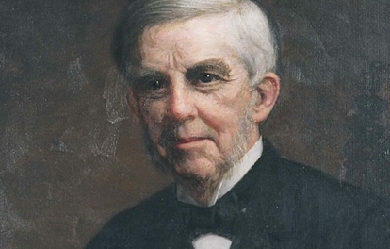
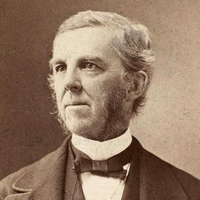
Oliver Wendell Holmes (August 29, 1809 – October 7, 1894) was an American physician, poet, and polymath based in Boston. Grouped among the fireside poets, he was acclaimed by his peers as one of the best writers of the day. His most famous prose works are the "Breakfast-Table" series, which began with The Autocrat of the Breakfast-Table (1858). He was also an important medical reformer. In addition to his work as an author and poet, Holmes also served as a physician, professor, lecturer, inventor, and, although he never practiced it, he received formal training in law.

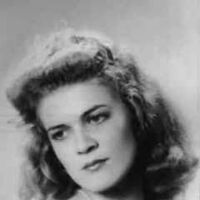
Carilda Oliver Labra. Poetisa cubana, Premio Nacional de Literatura (1998), nacida el 6 de julio de 1922 en la occidental provincia de Matanzas, específicamente en la capital provincial, ciudad en la que siempre ha vivido. Graduada de Derecho en la Universidad de La Habana en 1945, profesión que ha ejercido en su ciudad natal junto a su pasión por la poesía. Carilda Oliver: “He sido muy feliz siendo poeta” En el programa "Con 2 que se quieran”, 4 enero 2011. Amaury Pérez: Muy buenas noches, estamos en Con 2 que se quieran, ahora aquí en 5ta. Avenida y calle 32, en el barrio de Miramar, en los maravillosos Estudios Abdala. Una noche verdaderamente especial. Durante todos estos programas que han transcurrido hasta este momento, ustedes la pidieron, ustedes la solicitaron mediante sus correos, mediante sus cartas. Es la persona que más han solicitado. Yo lo he ido apuntando y así es y aquí está. Los ojos más bellos de la literatura cubana: una mujer extraordinariamente hermosa, una escritora de excelencia. Para cualquiera es emotivo presentarla, tenerla delante. Una mujer que irradia dulzura y ternura, la eminente poetisa cubana, matancera Carilda Oliver Labra. Señora, un beso, otro beso. Muchas gracias, yo estoy abrumado por su presencia, usted ha venido de Matanzas a estar aquí con nosotros y yo no puedo menos que rendirme a sus pies y agradecérselo. Y empezaremos nuestra conversación, más que una entrevista. Usted es Premio Nacional de Literatura. La pregunta sería. ¿Llegó a tiempo el Premio Nacional de Literatura? Carilda. Claro que te voy contestar y te voy a tratar de tú. Aunque no hemos tenido mucha oportunidad de vernos personalmente, pero te he visto en escena, en televisión, y en sueños… Amaury. Ay, Dios mío… Carilda. Primero, tengo que agradecerte la invitación. Amaury. Gracias, muchas gracias. Carilda. Después, todas esas cosas lindísimas que has dicho y en el transcurso del programa creo que se podrá ir haciendo presente esa admiración que es mutua. Amaury. Ah, muchas gracias. Carilda. Y que hoy para que no parezca esto una asociación de bombos recíprocos no te puedo hablar de tu música ni de tus interpretaciones. Yo creo que tú eres un poeta, lo de músico, ¡figúrate!, pero bueno, vamos a pasar a responder tu pregunta. Que si llegó, si tomó mucho tiempo… eso, en cierto modo, pues no es descorazonador, diríamos, no, no me angustió. Fui candidata 9 veces, o sea, 9 años seguidos, al Premio Nacional de Literatura que es, como todo el mundo sabe, el premio más importante en la carrera de un escritor. Fueron escogiendo los mejores escritores de Cuba, no puedo decir otra cosa, pero bueno, mi turno no llegaba y yo pensaba: bueno, es que yo no soy tan buena, yo no soy tan buena. Además, yo había tenido mis problemas, había estado fuera de las editoriales mucho tiempo, y decía: esto puede ser que influencie, era un tribunal, parece que compasivo, digo yo, también, a lo mejor no era tan justo, pero dirían: esta pobre mujer lleva 9 años esperando seguramente. No, yo ya no esperaba. Amaury. ¿No esperaba nada? Carilda. Cuando me lo dieron, que me llamaron por teléfono para decírmelo. Dije: Esto es una broma, esto es una broma. ¡Pero era verdad! Amaury. ¡Pero era verdad!, ¿y lo disfrutó? Carilda. ¡Ay, cómo no! Lo disfruté muchísimo, lo estoy disfrutando todavía. Sí, sí, porque eso, claro, es un compromiso, es un compromiso histórico y algo que nos obliga a tratar de ser mejores y ya va siendo imposible porque la vida…, con sus añitos… es posible que nos esté haciendo daño. Desde luego, nosotros no nos damos cuenta. Esto es una coquetería, esto es una coquetería. Amaury. Téngala conmigo porque la está teniendo con los televidentes nada más. La veo que mira para la cámara y para la cámara, tiene que hablarme a mí, porque me estoy poniendo celoso. Carilda. Yo coqueteo con los televidentes… (risas) Amaury. (risas) Yo estoy celoso, me estoy poniendo celoso de la cámara. Carilda. No esté celoso, porque más celoso estará mi marido. (risas) Amaury. Ah, sí, seguramente. (risas) Carilda. Y ten cuidado no se cele de ti porque es karateca. (risas) Amaury. ¡No. no, no! Además él sabe que usted es un amor antiguo mío, pero somos amigos, usted lo sabe, Raydel y yo somos amigos, así que no se va a poner celoso conmigo. Ahora, ¿Usted escogió el camino de la poesía, Carilda, o la poesía la escogió a usted? Carilda. Bueno, yo creo que sería presumir mucho por parte mía si digo que yo fui escogida por la poesía. Es presumir mucho. Lo que pasa que de ella no me he podido escapar. He sido muy feliz siendo poeta. No hubiera querido ser nada más. Amo mucho la música, la plástica. He intentado y hasta me he graduado de pintura, pero realmente… el ballet, bueno, el teatro, todas las artes, pero, sinceramente, nací poeta. Y quiero decirlo, porque cuando yo tenía tres o cuatro años, que mi mamá me cantaba canciones, ella me contó mucho tiempo después, que yo le modificaba las canciones. Amaury. ¿Ah, sí? Carilda. La letra. Amaury. La letra, claro. Carilda. Entonces ella dijo: esta niña va a ser poeta y parece que resultó. Claro, la poesía es muy difícil y me parece a mí, que aparte del don que se pueda traer, hay que estudiar y tiene mucho que ver con la técnica y con la inspiración. Amaury. Ahí vamos, porque hay gente que dice que no hace falta… que la inspiración no existe. Carilda. ¡Pero imagínate!, si no existiera la inspiración, si fuera una cosa de aprender lo que es un endecasílabo, lo que es una cesura, lo que es un hemistiquio, lo que es un soneto, lo que es un verso libre, pues sería, vaya, un objetivo de cualquier persona. Amaury. Cualquier persona se aprende la técnica y ya es poeta. Carilda. Claro y yo creo que…, claro, se pueden hacer versos, pero una cosa es un verso y otra cosa es la poesía, ¿eh?. El verso es la línea, el fondo, la forma, diría, la forma. Pero tú puedes aprender…, bueno, vamos a hacer octosílabos. Me voy a leer a Martí, que era magnífico poeta y que además en los octosílabos, sí, era un príncipe y ya, voy cogiendo esa música, que la rima y el ritmo, pero si se te fue la chispa, que es el fuego, es más que el fuego, la luz del verso, no puedes hacer poesía. Bueno, no es una lección, es una idea muy humilde. Amaury. Bueno, es humilde pero está viniendo de Carilda Oliver. No me lo está diciendo cualquiera. Carilda. Además, no creo que sea una idea mía, yo creo que todos los que escribimos sabemos. Hay veces que uno hace cosas que rompen. Que las miras después y en todo…, uno puede escribir un poema breve de cinco o seis o siete versos y tener un solo verso, y si merece la pena lo dejamos porque es imposible que, por ejemplo, en un soneto, los catorce versos sean buenos. Ahora, me preguntaba Gabriela Mistral. ¡Ay, bueno, es una anécdota…! Perdóname que te la haga. Amaury. No, ¡pero qué bueno que me la hace! Por favor. Carilda. Bueno, el día que tuve la dicha de conocerla, porque fue tan generosa Dulce María Loynaz, nuestra enorme, inmensa, inolvidable Dulce María, que me invitó a su casa, la primera vez que fui, porque estaba allí Gabriela. Y entonces Gabriela, después que leyó unos sonetos míos, me dice: con una modestia, que es digna de mencionar. No por lo que entraña el elogio que me hizo, sino por la forma en que ella asumió el conocimiento de una muchacha, como ella llamaba “del campo”, una niña del campo, porque yo era matancera y Dulce María era capitalina y además una mujer que había viajado y yo no había salido de Tirry 81 (calle y número de la casa de Carilda en Matanzas). Amaury. De Calzada de Tirry 81. Carilda. Fue después que he viajado y he tenido otras oportunidades, pero bueno, Tirry 81, para mí, es el planeta. Entonces, ¿qué pasa?, que ella me dice: ¿Y cómo cierra tan bien los sonetos? porque en el último verso a mí siempre se me va la fuerza, palabra textuales de Gabriela, y luego paso mucho trabajo y a fin de cuentas lo dejo así, ¿pero cómo tú lo cierras tan bien? y entonces yo le dije: A mí, casi siempre, los sonetos me suceden en los momentos menos oportunos. Estoy sentada en el cine viendo una película, y me viene un solo verso y me levanto y voy para mi casa a escribir, porque después se me olvida. Es así, eso va en aumento, porque la inspiración es como que se consolida en determinado momento, ya es como una efervescencia, como una llama que crece, que crece y que luego no se vuelve humo, sino se vuelve luz. Y ese verso de la luz, a veces, aparece en el segundo terceto, en el último, o aparece en el primer cuarteto, en cualquier parte, pero uno tiene que darse cuenta y dice: este es el final y lo pone al final y después empieza la rima de abajo para arriba. Amaury. Nunca había oído que nadie empezara un soneto de abajo para arriba. Carilda. Sí, pero eso es una técnica, que yo no sé si yo la descubrí, yo creo que no, pero es un recurso, es un apoyo, y ahí está el soneto a mi madre. Búscalo. Amaury. ¡A claro, claro! Aquí, este soneto, por ejemplo. (Amaury le acerca el soneto Madre mía que estás en una carta, escrito por Carilda) Carilda. No lo vamos a leer todo completo. Amaury. ¡Léalo completo!. Carilda. Ah, ¿completo? Amaury. Completo. Carilda. Y entonces ustedes verán que el último verso, que no lo voy a decir ahora, es realmente el cierre, pero es que ese fue el primero que yo escribí y no lo puse arriba porque echaba a perder el soneto. Amaury. ¡Qué bárbaro! Carilda. ¿Comprende? él se llama: “Madre mía que estás en una carta”. Madre mía que estás en una carta Y en un regaño antiguo que no encuentro. Quédate para siempre aquí en el centro de la rosa total que no se aparta. Madre mía que estás tan lejos Harta de la nieve y la bruma, Espera que entro a ponerte a vivir con el sol dentro Madre mía que estás en una carta. Puedes darle al misterio alguna cita, Convenir con las sombras hechiceras. Puede ser una piedra que se quita O secarte ahora mismo las ojeras, pero acuérdate madre de tu hijita, ¡No te atrevas a todo, no te mueras! Amaury. ¡Madre santa, es que eso es un poema! ¿Cuán duro fue, ya que me leyó esto, el exilio de sus padres, para usted, que decidió quedarse? Carilda. Bueno, imagínate si fue duro el exilio, que yo los acompañé al aeropuerto y en el momento que el avión despegó, yo me quedé sin habla y sin oír. Y recuperé el habla a las pocas horas y todavía me falta por recuperar, que ya es imposible, de eso hace muchos años, el oído derecho. Yo oigo solo de este oído, del izquierdo, que lo recuperé después, de la impresión. Eso fue muy duro, pero la decisión la tomé sin dame cuenta. Desde que empezaron con el asunto de los pasaportes y tengo que significar que ninguno de los dos era desafecto a la Revolución. Pero se iban en pos de hijos y en pos de nietos. Amaury. Claro. Carilda. Mi papá era abogado y quería sacarme el pasaporte como para embullarme, pero sin decírmelo, siempre me respetaron mucho mi opinión, ni siquiera hicieron presión. Y, era muy triste, porque imagínese, ellos se iban…, aparte del amor, de la compañía, yo estaba en aquel momento sola, no tenía a nadie. Pero yo soy una palma que nací aquí y aquí tengo la raíz y no me podía, de ningún modo cortar las raíces, me quedé, eso fue todo. Amaury. Bueno, ya no sé ni cómo hacer las preguntas. La gente tiene una imagen, la imagen que se quiere crear de Carilda. Pero evidentemente hay una Carilda imaginada y hay una Carilda real. Hay una oculta, la que habita en Tirry 81, la que tiene una familia, la que tiene hace veinte años un compañero, un matrimonio, su esposo. Y hay una que es la que la gente quiere fantasear, que es la que acusan de… los términos son feos, pero la Carilda que dicen que es libertina (Carilda ríe), que cuando uno se pone a buscar los sinónimos de libertina… Y yo, yo puedo dar fe en televisión de que usted es una dama, de que usted es una señora. Carilda. Gracias, gracias. Bueno, eso es hasta simpático, no me ha traumatizado, aunque desde luego, en cierto modo ha tergiversado la personalidad literaria de uno. A mí no me afecta desde el punto de vista personal. A mí…, Carilda, es así, es asao… generalmente los artistas arrastramos una serie de comentarios, que son muy convenientes porque así hablan de nosotros, buscan las poesías, y se venden los libros y entonces uno puede hacer una carrera, pudiéramos decir, vamos a llamarle así a esto de ser poeta, que no es ninguna carrera. Ser poeta es una cosa muy difícil, cuando uno, bueno, quiere serlo de verdad. Entonces ¿qué pasa?, que yo, figúrate, muy jovencita escribí el tal “Me desordeno…” y la gente siguió desordenándose por su cuenta (risas), pero me han echado la culpa a mí de todo. La cantidad de hombres que me han dicho a mí y de mujeres: Ay, le agradezco su Me desordeno, porque con esa poesía yo he enamorado y he hecho, y qué sé yo. Y a mí me da risa, porque esa poesía es hasta inocente, es inocente incluso esa parte que dice: “Cuando quiero besarte arrodillada“, esa parte, la gente le da unas explicaciones… que bueno, no lo voy a decir aquí porque estamos en la televisión (risas), pero los televidentes ya saben de lo que estoy hablando. Entonces…, me van a tachar todo esto… (risas) Amaury. (risas) No le vamos a tachar nada. Carilda. ¿Qué dirá el ICRT? (risas) Amaury. No, no, nada, el ICRT es muy comprensivo con este programa. (risas) Carilda. Ay, perdónenme, pero yo, bueno, soy un poco irreverente, pero buena muchacha. (risas) Lo de muchacha es peor que lo de irreverente (risas). Amaury. (risas) ¡Señora, señora, señora! Carilda. Bueno, chico, pero me estoy divirtiendo un poco. (risas) Amaury. Claro que sí, diviértase. Carilda. En estos programas hay que reírse también. Amaury. Claro, no se puede ser tan grave… Carilda. A veces tenemos que llorar por cosas…, que tampoco debiéramos llorar… Amaury. No, pero si yo lo que la quiero es ver divertida. ¿Cómo llorando? No, yo no quiero verla llorando. Carilda. Estoy divertida, pero es culpa tuya, porque yo no sé qué vueltas me has dado, que mira dónde me has puesto (risas), porque yo no iba a venir a ningún programa. Bueno, entonces me atreví a celebrar las piernas de los hombres, de un hombre. Amaury. De uno, claro, no de los hombres. Carilda. En uno están todos los demás. Entonces la boca, los ojos, vaya, decirles piropos a los hombres. Porque siempre eran a las mujeres y bueno, pues yo rompí con eso, porque yo no veo nada en eso de extraordinario, ni de cosas subversivas, irreverentes, que estoy faltando el respeto, porque piensan que estoy hablando de una cosa carnal. Y el amor es espiritual y carnal y tiene que integrarse de las dos cosas, porque si no realmente no responde a la verdadera esencia del amor. Y bueno, todas esas cosas empezaron a traerme, aparte de algunas cosas de la vida de uno, que se han ido deformando y se han exagerado cosas y pasiones. Han inventado cosas con Hemingway, que no pasó nada en lo absoluto, ese era un hombre muy caballeroso, que me dio un elogio, un piropo delante de periodistas y eso empezó a dar vueltas, es un ejemplo que pongo. Y bueno, a cada rato pues a la gente le ha parecido muy natural que yo tenga romances de acuerdo con los versos que he escrito y esos versos están escritos para mis esposos, para las personas que yo he amado y que me han amado. Mi vida ¡figúrate!, en la Ciudad de Matanzas, que es una ciudad como todo el mundo sabe, como todas las provincias de Cuba. Yo allí salía sola con mi novio, cosa que la gente no hacía, mi familia me lo permitía. Estoy hablando de los años 50. Mi primer matrimonio data del 52. Íbamos a sentarnos en el parque…, allí lo más que hacíamos era cogernos las manos. El primer noviazgo mío eran dos días a la semana por la noche, dos horas, y mi mamá sentada cerca, que uno no se podía dar ni un beso porque, ¡imagínate!, ella, cuando ya el novio se iba, se paraba a la mitad del zaguán y ya. Esas cosas de la época…, que ahora los jóvenes disfrutan de otra libertad que ¡bienvenida sea!, porque creo que todo aquello era… Mi mamá era de una educación española. Mis abuelos eran españoles, por parte de madre, pero siempre mi madre, a pesar de haberse educado en aquel sitio, me respetaba, me veía como…, ella decía que no se podía interferir en la vida de los hijos hasta el extremo de querer dirigirlos en todo, que había que dejarles que respiraran el aire de la libertad, que ella no lo había tenido de niña, que siempre estaba con la religión a cuestas. Y, fíjate que todo eso no juega con que después yo escribiera determinados versos, pero a lo mejor era aquel hálito que había en mi casa de respeto lo que me hizo soltarme como un pájaro y volar. Amaury. Y no como un papalote donde hay una cuerda. Porque el papalote parece que está libre, pero hay una cuerda que lo ata. Carilda. Exacto, perfecta la imagen, perfecta la imagen. No sé si te contesté. Amaury. Sí, claro que me contestó. No, me contestó, y de más, qué maravilla. Carilda. Me he casado tres veces. Estuve muchos años sin compañía. Luego llegó un muchacho joven a mi vida, demasiado joven. Toda la ciudad se escandalizó y yo diría que toda Cuba, cuando él empezó a visitarme. Él estuvo como dos años detrás de mí y yo me acuerdo que el primer día que lo vi, lo vi a través de la mirilla de la puerta. Esto no viene al caso, pero bueno. (risas) Amaury. ¡No, cómo no!, sí viene al caso, claro, porque yo voy a leer ahora una cosa que él me mandó. Carilda. ¿Ah, sí? Amaury. Así que sí viene al caso, aquí todo viene al caso y, viniendo de usted, más al caso. Carilda. Bueno, pues entonces yo lo veía por la mirilla de la puerta. Él tenía el pelo largo -¡imagínese! que andaba por los veinte años y yo andaba por… vamos a no hablar de eso. Amaury. No lo diga, no lo diga. Carilda. Yo decía: Este es otro de esos muchachos que vienen a leer versos y a enamorarla a una, porque yo tenía una casa y vivía sola en la casa ¿comprende?, y sabe cómo son las cosas, como había tanta diferencia de edad, yo siempre pensaba… y eso es cosa de malicia también del pueblo. Amaury. Claro. Carilda. Que no nos perdonaron cuando empezamos el romance y cuando nos casamos. Siempre creyeron que él venía por la casa y porque ya yo tenía cierto nombre, y que él era un muchacho joven que empezaba. Pero yo me enamoré de aquel muchacho por muchas cosas. La primera porque la soledad es una cosa terrible, llevaba años viuda…, con mis gatos. Amaury. Con sus gatos, ¡qué maravilla! Carilda. Mis gatos que han sido mis nenés, mis niñitos, mis compañeros. Bueno, y ahí me conoció él, que yo no tenía ni un centavo y él tenía una casa magnífica donde vivir, había huido del campo porque quería estudiar y esa es la historia de ese joven. Amaury. Claro, él me manda hoy, porque no pudo venir al programa por asuntos personales vinculados con su mamá. Él me manda una carta que no voy a leer completamente porque es una carta privada, pero hay una parte que sí quiero compartir con Carilda, que no la conoce. Carilda. No. Amaury. Y con ustedes. Él me dice, bueno, empieza con “Mi muy admirado Amaury”, muy cariñoso. “Lamento profundamente no asistir a este encuentro con nuestra Carilda. Pero me ha resultado imposible” (y ahí me explica por qué). Pero después dice: “Gracias Amaury por llevarte contigo, en esta feliz ocasión, a una mujer que ya no se puede amar desde un solo cuerpo, que se ha hecho menos mía para volverse propiedad de un pueblo que ha encontrado en su voz la suya propia, prohijada por un deseo interminable de amor y de vida.” Y después me señala: “Hay muchas personas que tal vez contemplen nuestra pareja como un sacrilegio porque nos hemos atrevido a unir nuestras dos juventudes en un matrimonio que ya casi cumple dos decenios.” Y es lo que usted ahora ha estado aclarando y eso es lo que me manda a decir. Carilda. ¡Qué casualidad! Amaury. Ahora, él toca aquí un punto, fíjese que yo no lo tenía ni anotado… pero él toca un punto donde dice, hablando de usted y, ahora entonces vamos a hablar de este tema que él toca aquí. “Carilda ha tenido fe en la justicia, en el amor de su gente y en el triunfo de la verdad. Por ello en mi opinión creo que durante aquellos casi veinte años de silencio en su amada Patria, no supo en la soledad ser infeliz.” ¿Por qué usted cree que hubo tanto tiempo sin que a usted la consideraran lo que siempre ha sido? Una cubana fiel, digna y amante de su Patria. Carilda. Bueno, hay cosas que realmente ni el tiempo ha podido aclarar. Porque la verdad, sí, yo siempre creí que todo pasaría y así fue, todo pasó. Yo había escrito, inclusive, un Canto a Fidel cuando estaba en la Sierra (Maestra) porque yo había conocido a Fidel en la Universidad. Ya yo terminando en la Universidad, Derecho, él empezaba y, naturalmente, al ver que estaba en la Sierra -y esa historia no la voy a hacer porque es larga y ya se ha publicado- Me emocionó mucho aquel compañero de la adolescencia, que alentaba una Revolución que era una esperanza. Amaury. Un símbolo. Carilda. Y así, bueno, entonces ¿qué sucede? La Revolución realmente triunfó, pero inmediatamente, casi, a mí me dejaron cesante de mi trabajo. ¿Por qué? porque yo trabajaba en la Alcaldía de Matanzas. Porque las revoluciones son convulsas y cuando comienzan, como en este caso, hay un problema: Que hay mucha gente que se sube al carro de la Revolución sin haber estado en esa Revolución. Y a mí me parece que los intermediarios fueron, no en este caso, pero en muchos casos, fueron responsables de las injusticias y de las cosas que pasaron. Yo tuve la suerte de que no me quedé completamente cesante y esto es muy bueno decirlo, porque siempre hay alguien que esclarece, que salva, que es un abogado, que hoy es muy notable y es uno de los defensores de los Cinco Héroes, que es el doctor Rodolfo Dávalos. Amaury. Una eminencia, el doctor Dávalos es una eminencia. Carilda. Una eminencia, jurista y él me dijo: no, no importa, tú eres abogada y tú no has cometido delitos… Además, tú tienes ese Canto a Fidel. Él es poeta, pero de esos silenciosos, que no publican. Amaury. Sí, que no quiere publicar. Carilda. Tremendo escritor ¿eh?. Y entonces, bueno, entré en aquel bufete colectivo y fui muy feliz en ese bufete, porque allí se pudo hacer mucha justicia y muchas cosas y no se habló de nada. Pero el veto empezó a pesar de estar yo en el bufete. Amaury. ¿Y no se le publicaba entonces, nada? Carilda. Esto es bueno que se sepa, ¡qué me van a publicar! Pasaron muchas cosas. Amaury. ¿Y cuándo termina el veto? Carilda. Eso termina un día, un buen día, un magnífico día, estoy nombrando personas porque estoy hablando verdades. Amaury. Claro, claro. Carilda. No me gusta hacer anonimatos, y fulano, y que esto. Bueno y además, estoy muy agradecida al doctor Armando Hart. Amaury. Un hombre de la cultura y un hombre justiciero. Carilda. Se apareció en Matanzas un día, a averiguar qué pasaba conmigo, porque él no entendía nada. Amaury. Pero usted nunca abandonó ninguna Revolución ¿qué Revolución abandonó usted? Carilda. ¿Pero qué abandono?, ¡pero si no me exilé con toda mi familia y seguí en mi Tirry 81 pasando calamidades! Yo he comido sopas de yerbas y todas esas cosas. Yo tuve que arrancar las puertas grandes de Tirry 81, que están detrás de las ventanas, para un pobre guajiro que vino, bueno, no era pobre porque tenía más dinero que yo, y me compró las puertas y con eso comí como seis meses. ¡Ay, pero no soy ninguna víctima! Amaury. ¡Claro que no!. Carilda. No, no, no. Amaury. ¡Y con esos ojos!. Carilda. Muy dichosa. Muy dichosa, porque escribí más poesía que nunca. Escribe y escribe y escribe y feliz, feliz. Amaury. Bueno, aquí están sobre la mesa sus libros… Carilda trajo sus libros. Yo me he quedado frío. Carilda. Tengo 43 libros. Claro, entre ediciones, reediciones y cosas en el extranjero. En España tengo cinco libros. Amaury. Ahora, yo quiero de todas maneras, porque cuando hablamos por teléfono el otro día… Carilda. Sí. Amaury. …Hablamos mucho, hablamos más por teléfono que lo que vamos a hablar en la entrevista. Y pasó una cosa bien curiosa, porque yo le dije que a mí me encantaba este soneto, de Sonetos a mi padre, el cuarto soneto. Carilda. Ah, sí. Amaury. Y usted de pronto me dijo: qué casualidad, era el que le gustaba a ¡Eliseo Diego! Carilda. Sí, así mismo es. Amaury. Léame, por favor, ese soneto. Carilda. ¿El último? Amaury. Ese soneto, el último, yo se lo escogí. Carilda. Este es el Cuarto Soneto de la colección, pero cuatro son demasiado. Tu sillón de dentista ¿dónde está? Tu violín de estudiante, ¿cómo suena? Enterrabas centavos en la arena Y otros nombres ponías a mamá. Guardo todas tus cartas y retratos En mis sueños tu próstata se cura, Por el fondo del patio y la ternura Se encaminan tus últimos zapatos. Quiero verte salir en un postigo, ¡Ven fantasma, ven ángel oportuno! Ya no sé lo que hago, lo que digo, Porque quiero beber el desayuno, Con mi padre, mi sabio, mi mendigo En Calzada de Tirry 81. Amaury. ¡Es que es algo…, es precioso ese soneto! y se ve que a usted le afecta, todavía le afecta. No sé ni para qué lo traje. Fíjese qué rápido vamos a hablar de otro tema. A ver si usted me quiere decir este secreto. En este libro (Amaury le muestra un libro) hay una carta, están sus prosas, aparte que hay una foto aquí tremenda, la foto de la portada, con el pelo corto. Carilda. Está agotado ese libro. Amaury. Ese libro está agotado, ah, bueno. Pero ya uno va teniendo cosas que están agotadas, uno se va quedando con ellas. Pero hay un momento, donde hay varias cartas. Usted no quiere, ya me lo dijo por teléfono, hablar de a quién le había hecho las cartas y yo, por supuesto, respeto eso, pero no puedo privar al televidente de esa Carilda irónica que aparece aquí en un momento de esta carta. Carilda. ¡Ah!, va a leer esa, ¡vale!. Amaury. En un momento de esta carta yo por poquito me…, yo me arrastré cuando la leí la primera vez -carta número 4 se llama-, Te escribo por recomendación de este papel amarillo que vi sobre la mesa y para que me perdones el incumplimiento de la amenaza: El director tropieza con todos los sueños, así que dispuso sin mi permiso, que trabajara hoy de noche. Como te encantan las sorpresas, estarás muy contento de ver a otra mujer y no a la que pronosticó el telegrama. Pues bien, deseo con todos los humores negros de mi venganza, que solo caiga en tus brazos una soprano calva de 190 libras. No vamos a hablar de a quién se la hizo, pero vamos a hablar de esa Carilda maldita, esa Carilda, que vaya, es que no… “Lo que deseo es que caiga en tus brazos una soprano calva de 190 libras“. (risas) Carilda. (risas) Ay, son cosas de la juventud. Amaury. Ahora, ¿cómo fue aquello del tren que viene de Santiago, pasa por Matanzas y una persona que la amaba le ponía mensajes en el tren? ¿Qué cosa es eso, Carilda? Carilda. Ay, pero mira lo que estás sacando hoy. Óyeme, pero ¿cuántos cuentos te han hecho? Qué cosas… Amaury. Pero es que eso es tan bello. Carilda. Bueno, es verdad, es una cosa de…, y estoy hablando del año 50, porque fue el año, lo recuerdo perfectamente, en que salió Al sur de mi garganta. Al sur… nace en el 49, pero se lleva el Premio Nacional de Poesía del 50. Y entonces él es un poeta, por cierto, un poeta muy singular, porque es que tenía muchos oficios y era matemático, era graduado de La Sorbona, de Yale, yo no sé de cuántos lugares. Era un hombre muy talentoso que apareció en Cuba. Y como él quería enamorarse, porque él quería enamorarse de algún modo de alguna cubana, y sobre todo que fuera un amor imposible, digo yo, porque hizo todo lo posible. Yo tenía mi novio, yo era novia de Hugo Ania que era un noviazgo reciente y que después nos casamos. Y entonces, pues… No voy a contar lo que pasó en el medio, porque hubo problemas muy serios. Amaury. No, no. Carilda. Esa es la mitología con que el pueblo cubano me ha adornado a mí, porque ese mito es un adorno. Amaury. Claro. Carilda. La gente quiere que yo sea como me han inventado. Amaury. Exactamente. Carilda. Y realmente yo soy una señora muy respetable, ¡Ay!, ¿qué dije? (se tapa la boca) Amaury. No, sí lo es. Sí, Carilda, sí lo es. Carilda. No, pero es que todo el mundo se va a disgustar. Amaury. No, nadie se va a disgustar. Carilda. ¿Tú crees que no? Amaury. No, nadie se va a disgustar. La gente va a seguir con la mitología que quiera crearse sobre usted. Pero es bueno que de una vez se diga, que lo importante de usted, aparte de su belleza, aparte de su talento, de su simpatía, es su gran obra poética, que es lo que la va a trascender. Y la mitología que la gente se crea sobre los artistas, esa se va a quedar en el camino y lo que va a quedar al final, son estos poemas, son estos libros, eso es lo que va… Carilda. …Ay, Amaury. ¡Qué generoso eres! Amaury. No, generoso no, soy justo con usted. Carilda. Te quiero. Amaury. Carilda ¿Y entonces lo del tren? ¿El tren salía de dónde? Carilda. Él tren venía de Santiago y llegaba a La Habana, aquí, pero claro, pasaba por Matanzas. Y entonces, este escritor, uruguayo, me escribía, después que se fue de Matanzas, me escribía desde allá. Pero él quería que llegaran las cosas tan pronto que iba al último vagón del tren. Ya me lo había advertido por teléfono: por la mañana me decía: Carilda, ahora voy a escribirte un mensaje en la pared del vagón último del tren, bueno, yo iba por la noche cuando llegaba el tren a Matanzas a ver aquello, a leer aquello. ¡Qué lindas cosas escribía! Amaury. Por eso ahí empiezan las historias. Carilda. Y ahí empiezan las historias de Carilda ¿comprende? Amaury. Claro Carilda. Que después de todo son historias muy lindas y no hay por qué renunciar a ellas. Amaury. Pero mire, yo le voy a decir algo. El pueblo cubano, el lector cubano y más que el lector cubano, incluso, el que no la ha leído -que se está perdiendo una de las maravillas del mundo- la quiere a usted, usted es amada. Usted es amada por todo el mundo. Carilda. No, porque amo, porque amo al pueblo. Amaury. Claro, porque eso va y viene, eso es un efecto de ida y vuelta. Ahora, yo quiero, Carilda, porque ya el programa lo estamos terminando. Mire, usted me trajo hoy de regalo la última edición de Al sur de mi garganta, es esta. Carilda. 60 años cumplió el año pasado. Amaury. Con una dedicatoria que es para mi corazón, yo no voy a leer lo que dice, que es muy emocionante y ya yo tengo hace rato los ojos aguados. Pero es que yo traje para que Carilda me firmara… Carilda. …¡Ay, chico!… Amaury. …La edición Príncipe… Carilda. …Eso me emocionó… Amaury. …De Al sur de mi garganta... Carilda. Porque nadie la tiene, porque se hicieron 300 ejemplares. Imagínense, en el año 49. Amaury. Claro, del 49 y esto se lo regala a mi tío Raúl y por supuesto a mi tía María Luisa también, Pascualito, un amigo, el 11 de marzo de 1950. Y aquí está con las ilustraciones. ¿Cuántos libros se hicieron de esta edición? Carilda. 300 nada más. Esto lo pagó mi padre. Entonces no había editoriales. Amaury. ¡Fíjese que es propiedad del autor!. Carilda. Y tuve la suerte de que con ese librito gané el premio. Amaury. Entonces usted me va a hacer el favor de poner su nombre aquí. Y después, porque estamos en televisión, me pone una cosita más, porque eso es un tesoro de la biblioteca nuestra, de mi esposa y mía. Un programa bien emotivo y bien difícil. Esto no se puede creer. Carilda. Es que tú no habías nacido cuando el libro se publicó. Amaury. ¡Claro que no había nacido!. Carilda. Ah, imagínate. Amaury. Pero ya había nacido usted, había nacido su poesía y a lo mejor, quién sabe si yo nací de algún poema de estos. Entonces, ahora va a terminar el programa usted. Yo antes le voy a agradecer su gentileza, su viaje, el suyo y el de sus compañeros que la han traído. Ha sido un programa muy especial. Es además el programa con el que estamos comenzando este año 2011, es el primer programa de enero de 2011. Todavía hay una grata temperatura afuera, hemos acabado de pasar las Navidades…, yo quiero que usted me lea este poema que es uno de los poemas que más me gusta suyo, y que de esa manera despida el programa y le agradezco señora, su poesía, su talante, su genio, su gentileza, su belleza. Su amor a Cuba, su amor a la Patria. Carilda. Gracias, la agradecida soy yo. Gracias. Adiós locura de mis treinta años, Besado en julio bajo luna llena, Al tiempo de la herida y la azucena Adiós mi venda de taparme daños. Adiós mi excusa, mi desorden bello, mi alarma tierna, mi ignorante fruta Estrella transitoria que se enluta, Esperanza de todo por mi cuello. Adiós muchacho de la cita corta, Adiós pequeña ayuda de mi aorta, Tristísimo juguete violentado Adiós verde placer, falso delito Adiós sin una queja, sin un grito Adiós mi sueño nunca abandonado. Amaury. Gracias, Carilda, muchas gracias por existir. Nos veremos pronto. Carilda. Gracias. Petí arregla el vestido de la poeta y Solís verifica que el micrófono permita escuchar con nitidez la voz de Carilda. El programa está por comenzar. Referencias Cuba Debate - www.cubadebate.cu/noticias/2011/01/04/carilda-oliver-he-sido-muy-feliz-siendo-poeta/ BIOGRAFÍA Su primer libro, "Preludio Lírico", fue publicado en Matanzas en 1943. En esta selección de poemas escritos entre 1939 y 1942, ya se hacen presentes: -El amor, con sus devanes, inquietudes, zozobras, desalientos, aciertos, quizás con una pluma inexperta que no sabía dominar emociones e impregnada del entorno un tanto melodramático que a muchos atacaba; -La familia, la abuela, la madre y el padre presentes en un cuadro que no desaparecerá nunca de su obra. Después de obtener el Segundo Lugar en el Concurso Internacional de Poesía, organizado por la National Broadcasting Co. de Nueva York, Estados Unidos, publica en 1949 "Al sur de mi garganta", libro con el que ganó el Premio Nacional de Poesía, al mismo tiempo que trabaja en la biblioteca Gener y del Monte, es declarada Hija Eminente de la Atenas de Cuba. En esa misma temporada culmina sus estudios en la Escuela de Artes Plásticas de Matanzas que la acreditan como profesora de Dibujo, Pintura y Escultura y contrajo nupcias con el abogado y poeta Hugo Ania Mercier, de quien se divorciaría en 1955 tras una relación turbulenta. Tuvo otros 2 matrimonios: Félix Pons, cuya muerte la inspiró para su libro "Se me ha perdido un hombre" y finalmente Raidel Hernández, muy joven, con quien comparte ahora su vida. Se le reconoce una intensa labor como profesora en escuelas de su natal Matanzas, ligando a su amor por el magisterio su trabajo como abogada y su pasión por la poesía. Hasta la actualidad cuenta con 43 publicaciones que incluyen prosa y poesía, más varios premios y reconocimientos. Poemas suyos han sido traducidos al inglés, francés, italiano, ruso, búlgaro, rumano y vietnamita. Desde 1980 funciona en Madrid una Tertulia Poética que lleva su nombre y que, además, convoca anualmente a un Premio Internacional de Poesía. Aunque su obra transmite muchas veces dolor, añoranza o vacío, desde el "Me desordeno amor..." que hizo con tan solo 24 años, su poesía está cargada de sensualidad, desenfado, seducción, y la muestran progresista, liberal y hasta un tanto irreverente. En una ocasión comentó: "Tal vez me colgaron la etiqueta de erótica porque conocen más esa proyección mía que las otras. Es la que escogen los declamadores, la que aparece en programas radiales y aquella que se ha musicalizado y difundido casi sin yo darme cuenta." Ella misma nos da su receta de erotismo: “Hay que renunciar a traducir su misterio. Entre el erotismo y la profanación, entre lo que debe ser y lo que tiene que ser hay una línea divisoria muy fina. Nace, no se aprende”. Referencias Wikipedia - es.wikipedia.org/wiki/Carilda_Oliver Cuba Literaria - www.cubaliteraria.cu/autor/carilda_oliver/biografia.html Ecured - www.ecured.cu/index.php/Carilda_Oliver_Labra
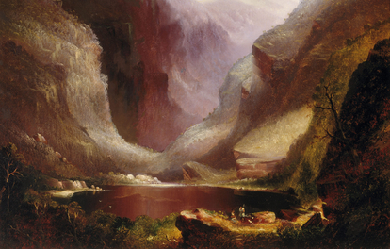
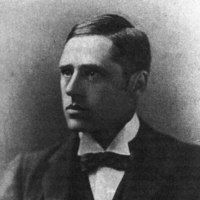
Andrew Barton “Banjo” Paterson, CBE (17 February 1864– 5 February 1941) was an Australian bush poet, journalist and author. He wrote many ballads and poems about Australian life, focusing particularly on the rural and outback areas, including the district around Binalong, New South Wales, where he spent much of his childhood. Paterson’s more notable poems include “Waltzing Matilda”, “The Man from Snowy River” and “Clancy of the Overflow”.
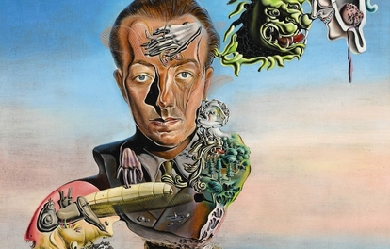
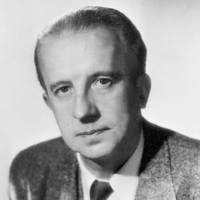
Eugène Grindel, dit Paul Éluardais né à Saint-Denis le 14 décembre 1895 et mort à Charenton-le-Pont le 18 novembre 1952 (à 56 ans). En 1916, il choisit le nom de Paul Éluard, hérité de sa grand-mère, Félicie. Il adhère au dadaïsme et devient l’un des piliers du surréalisme en ouvrant la voie à une action artistique politiquement engagée auprès du Parti communiste. Il est connu également sous les noms de plume de Didier Desroches et de Brun.
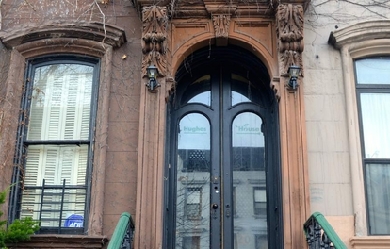
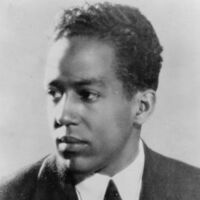
James Mercer Langston Hughes (February 1, 1902 – May 22, 1967) was an American poet, social activist, novelist, playwright, and columnist. He was one of the earliest innovators of the then-new literary art form jazz poetry. Hughes is best known for his work during the Harlem Renaissance. He famously wrote about the period that “the negro was in vogue” which was later paraphrased as “when Harlem was in vogue”.
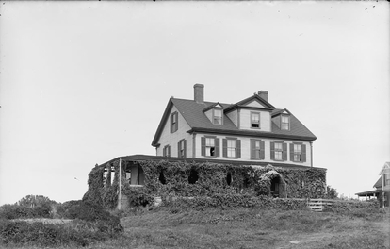
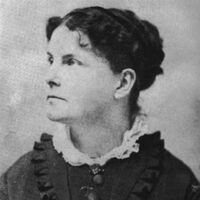
Celia Laighton Thaxter (June 29, 1835 – August 25, 1894) was an American writer of poetry and stories. She was born in Portsmouth, New Hampshire. Thaxter grew up in the Isles of Shoals, first on White Island, where her father, Thomas Laighton, was a lighthouse keeper, and then on Smuttynose and Appledore Islands. When she was sixteen, she married Levi Thaxter and moved to the mainland, residing first in Watertown, Massachusetts at a property his father owned. Celia died suddenly while on Appledore Island. She was buried not far from her cottage, which unfortunately burned in the 1914 fire that destroyed The Appledore House hotel.
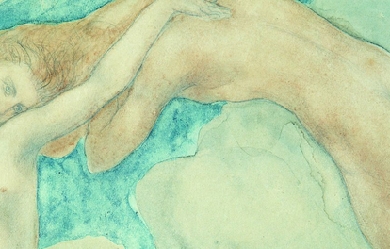
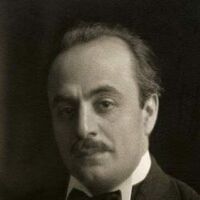
Khalil Gibran (Arabic pronunciation: [xaˈliːl ʒiˈbrɑːn]) (January 6, 1883 - April 10, 1931); born Gubran Khalil Gubran, was a Lebanese-American artist, poet, and writer. Born in the town of Bsharri in modern-day Lebanon (then part of the Ottoman Mount Lebanon mutasarrifate), as a young man he emigrated with his family to the United States where he studied art and began his literary career. In the Arab world, Gibran is regarded as a literary and political rebel. His Romantic style was at the heart of a renaissance in modern Arabic literature, especially prose poetry, breaking away from the classical school. In Lebanon, he is still celebrated as a literary hero. He is chiefly known in the English-speaking world for his 1923 book The Prophet, an early example of inspirational fiction including a series of philosophical essays written in poetic English prose. The book sold well despite a cool critical reception, gaining popularity in the 1930s and again especially in the 1960s counterculture. Gibran is the third best-selling poet of all time, behind Shakespeare and Lao-Tzu. In academic contexts his name is often spelled Jubrān Khalīl Jubrān,:217:255 Jibrān Khalīl Jibrān,:217:559 or Jibrān Xalīl Jibrān;:189 Arabic جبران خليل جبران , January 6, 1883 – April 10, 1931) also known as Kahlil Gibran, In Lebanon Gibran was born to a Maronite Catholic family from the historical town of Bsharri in northern Lebanon. His mother Kamila, daughter of a priest, was thirty when he was born; his father Khalil was her third husband. As a result of his family's poverty, Gibran received no formal schooling during his youth. However, priests visited him regularly and taught him about the Bible, as well as the Arabic and Syriac languages. Gibran's father initially worked in an apothecary but, with gambling debts he was unable to pay, he went to work for a local Ottoman-appointed administrator. Around 1891, extensive complaints by angry subjects led to the administrator being removed and his staff being investigated. Gibran's father was imprisoned for embezzlement, and his family's property was confiscated by the authorities. Kamila Gibran decided to follow her brother to the United States. Although Gibran's father was released in 1894, Kamila remained resolved and left for New York on June 25, 1895, taking Khalil, his younger sisters Mariana and Sultana, and his elder half-brother Peter (in Arabic, Butrus). In the United States The Gibrans settled in Boston's South End, at the time the second largest Syrian/Lebanese-American community in the United States. Due to a mistake at school, he was registered as Kahlil Gibran. His mother began working as a seamstress peddler, selling lace and linens that she carried from door to door. Gibran started school on September 30, 1895. School officials placed him in a special class for immigrants to learn English. Gibran also enrolled in an art school at a nearby settlement house. Through his teachers there, he was introduced to the avant-garde Boston artist, photographer, and publisher Fred Holland Day, who encouraged and supported Gibran in his creative endeavors. A publisher used some of Gibran's drawings for book covers in 1898. Gibran's mother, along with his elder brother Peter, wanted him to absorb more of his own heritage rather than just the Western aesthetic culture he was attracted to, so at the age of fifteen, Gibran returned to his homeland to study at a Maronite-run preparatory school and higher-education institute in Beirut, called Al-Hikma (The Wisdom). He started a student literary magazine with a classmate and was elected "college poet". He stayed there for several years before returning to Boston in 1902, coming through Ellis Island (a second time) on May 10. Two weeks before he got back, his sister Sultana died of tuberculosis at the age of 14. The next year, Peter died of the same disease and his mother died of cancer. His sister Marianna supported Gibran and herself by working at a dressmaker’s shop. Art and poetry Gibran held his first art exhibition of his drawings in 1904 in Boston, at Day's studio. During this exhibition, Gibran met Mary Elizabeth Haskell, a respected headmistress ten years his senior. The two formed an important friendship that lasted the rest of Gibran’s life. Though publicly discreet, their correspondence reveals that the two were lovers. In fact, Gibran twice proposed to her but marriage was not possible in the face of her family's conservatism. Haskell influenced not only Gibran’s personal life, but also his career. She became his editor, and introduced him to Charlotte Teller, a journalist,and Emilie Michel (Micheline), a French teacher, who accepted to pose for him as a model and became close friends. In 1908, Gibran went to study art in Paris for two years. While there he met his art study partner and lifelong friend Youssef Howayek. While most of Gibran's early writings were in Arabic, most of his work published after 1918 was in English. His first book for the publishing company Alfred A. Knopf, in 1918, was The Madman, a slim volume of aphorisms and parables written in biblical cadence somewhere between poetry and prose. Gibran also took part in the New York Pen League, also known as the "immigrant poets" (al-mahjar), alongside important Lebanese-American authors such as Ameen Rihani, Elia Abu Madi and Mikhail Naimy, a close friend and distinguished master of Arabic literature, whose descendants Gibran declared to be his own children, and whose nephew, Samir, is a godson of Gibran's. Much of Gibran's writings deal with Christianity, especially on the topic of spiritual love. But his mysticism is a convergence of several different influences : Christianity, Islam, Sufism, Hinduism and theosophy. He wrote : "You are my brother and I love you. I love you when you prostrate yourself in your mosque, and kneel in your church and pray in your synagogue. You and I are sons of one faith - the Spirit." Juliet Thompson, one of Gibran's acquaintances, reported several anecdotes relating to Gibran: She recalls Gibran met `Abdu'l-Bahá, the leader of the Bahá’í Faith at the time of his visit to the United States, circa 1911–1912. Barbara Young, in "This Man from Lebanon: A Study of Khalil Gibran", records Gibran was unable to sleep the night before meeting `Abdu'l-Bahá who sat for a pair of portraits. Thompson reports Gibran saying that all the way through writing of "Jesus, The Son of Man", he thought of `Abdu'l-Bahá. Years later, after the death of `Abdu'l-Bahá, there was a viewing of the movie recording of `Abdu'l-Bahá – Gibran rose to talk and in tears, proclaimed an exalted station of `Abdu'l-Bahá and left the event weeping. His poetry is notable for its use of formal language, as well as insights on topics of life using spiritual terms. Gibran's best-known work is The Prophet, a book composed of twenty-six poetic essays. Its popularity grew markedly during the 1960s with the American counterculture and then with the flowering of the New Age movements. It has remained popular with these and with the wider population to this day. Since it was first published in 1923, The Prophet has never been out of print. Having been translated into more than forty languages, it was one of the bestselling books of the twentieth century in the United States. One of his most notable lines of poetry is from "Sand and Foam" (1926), which reads: "Half of what I say is meaningless, but I say it so that the other half may reach you". This line was used by John Lennon and placed, though in a slightly altered form, into the song "Julia" from The Beatles' 1968 album The Beatles (a.k.a. "The White Album”). Drawing and painting Gibran was an accomplished artist, especially in drawing and watercolour, having attended art school in Paris from 1908 to 1910, pursuing a symbolist and romantic style over then up-and-coming realism. His more than 700 images include portraits of his friends WB Yeats, Carl Jung and August Rodin. A possible Gibran painting was the subject of a June 2012 episode of the PBS TV series History Detectives. Political thought Gibran was by no means a politician. He used to say : "I am not a politician, nor do I wish to become one" and "Spare me the political events and power struggles, as the whole earth is my homeland and all men are my fellow countrymen". Nevertheless, Gibran called for the adoption of Arabic as a national language of Syria, considered from a geographic point of view, not as a political entity. When Gibran met `Abdu'l-Bahá in 1911–12, who traveled to the United States partly to promote peace, Gibran admired the teachings on peace but argued that "young nations like his own" be freed from Ottoman control. Gibran also wrote the famous "Pity The Nation" poem during these years, posthumously published in The Garden of the Prophet. When the Ottomans were finally driven out of Syria during World War I, Gibran's exhilaration was manifested in a sketch called "Free Syria" which appeared on the front page of al-Sa'ih's special "victory" edition. Moreover, in a draft of a play, still kept among his papers, Gibran expressed great hope for national independence and progress. This play, according to Khalil Hawi, "defines Gibran's belief in Syrian nationalism with great clarity, distinguishing it from both Lebanese and Arab nationalism, and showing us that nationalism lived in his mind, even at this late stage, side by side with internationalism.” Death and legacy Gibran died in New York City on April 10, 1931: the cause was determined to be cirrhosis of the liver and tuberculosis. Before his death, Gibran expressed the wish that he be buried in Lebanon. This wish was fulfilled in 1932, when Mary Haskell and his sister Mariana purchased the Mar Sarkis Monastery in Lebanon, which has since become the Gibran Museum. The words written next to Gibran's grave are "a word I want to see written on my grave: I am alive like you, and I am standing beside you. Close your eyes and look around, you will see me in front of you ...." Gibran willed the contents of his studio to Mary Haskell. There she discovered her letters to him spanning twenty-three years. She initially agreed to burn them because of their intimacy, but recognizing their historical value she saved them. She gave them, along with his letters to her which she had also saved, to the University of North Carolina at Chapel Hill Library before she died in 1964. Excerpts of the over six hundred letters were published in "Beloved Prophet" in 1972. Mary Haskell Minis (she wed Jacob Florance Minis in 1923) donated her personal collection of nearly one hundred original works of art by Gibran to the Telfair Museum of Art in Savannah, Georgia in 1950. Haskell had been thinking of placing her collection at the Telfair as early as 1914. In a letter to Gibran, she wrote "I am thinking of other museums ... the unique little Telfair Gallery in Savannah, Ga., that Gari Melchers chooses pictures for. There when I was a visiting child, form burst upon my astonished little soul." Haskell's gift to the Telfair is the largest public collection of Gibran’s visual art in the country, consisting of five oils and numerous works on paper rendered in the artist’s lyrical style, which reflects the influence of symbolism. The future American royalties to his books were willed to his hometown of Bsharri, to be "used for good causes”. Works In Arabic: * Nubthah fi Fan Al-Musiqa (Music, 1905) * Ara'is al-Muruj (Nymphs of the Valley, also translated as Spirit Brides and Brides of the Prairie, 1906) * al-Arwah al-Mutamarrida (Rebellious Spirits, 1908) * al-Ajniha al-Mutakassira (Broken Wings, 1912) * Dam'a wa Ibtisama (A Tear and A Smile, 1914) * al-Mawakib (The Processions, 1919) * al-‘Awāsif (The Tempests, 1920) * al-Bada'i' waal-Tara'if (The New and the Marvellous, 1923) In English, prior to his death: * The Madman (1918) (downloadable free version) * Twenty Drawings (1919) * The Forerunner (1920) * The Prophet, (1923) * Sand and Foam (1926) * Kingdom of the Imagination (1927) * Jesus, The Son of Man (1928) * The Earth Gods (1931) Posthumous, in English: * The Wanderer (1932) * The Garden of the Prophet (1933, Completed by Barbara Young) * Lazarus and his Beloved (Play, 1933) Collections: * Prose Poems (1934) * Secrets of the Heart (1947) * A Treasury of Kahlil Gibran (1951) * A Self-Portrait (1959) * Thoughts and Meditations (1960) * A Second Treasury of Kahlil Gibran (1962) * Spiritual Sayings (1962) * Voice of the Master (1963) * Mirrors of the Soul (1965) * Between Night & Morn (1972) * A Third Treasury of Kahlil Gibran (1975) * The Storm (1994) * The Beloved (1994) * The Vision (1994) * Eye of the Prophet (1995) * The Treasured Writings of Kahlil Gibran (1995) Other: * Beloved Prophet, The love letters of Khalil Gibran and Mary Haskell, and her private journal (1972, edited by Virginia Hilu) Memorials and honors * Lebanese Ministry of Post and Telecommunications published a stamp in his honor in 1971. * Gibran Museum in Bsharri, Lebanon * Gibran Khalil Gibran Garden, Beirut, Lebanon * Gibran Khalil Gibran collectin, Soumaya Museum, Mexico. * Kahlil Gibran Street, Ville Saint-Laurent, Quebec, Canada inaugurated on 27 Sept. 2008 on occasion of the 125th anniversary of his birth. * Gibran Kahlil Gibran Skiing Piste, The Cedars Ski Resort, Lebanon * Kahlil Gibran Memorial Garden in Washington, D.C., dedicated in 1990 * The Kahlil Gibran Chair for Values and Peace, University of Maryland, currently held by Suheil Bushrui * Pavilion K. Gibran at École Pasteur in Montréal, Quebec, Canada * Gibran Memorial Plaque in Copley Square, Boston, Massachusetts see Kahlil Gibran (sculptor). * Khalil Gibran International Academy, a public high school in Brooklyn, NY, opened in September 2007 * Khalil Gibran Park (Parcul Khalil Gibran) in Bucharest, Romania * Gibran Kalil Gibran sculpture on a marble pedestal indoors at Arab Memorial building at Curitiba, Paraná, Brazil * Gibran Khalil Gibran Memorial, in front of Plaza de las Naciones. Buenos Aires. References Wikipedia - http://en.wikipedia.org/wiki/Khalil_Gibran
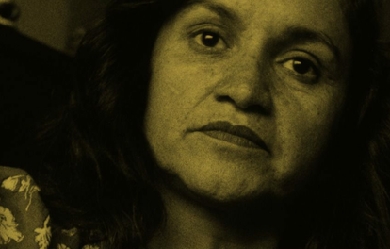
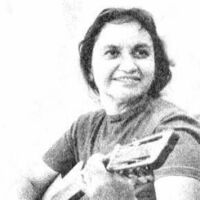
Violeta del Carmen Parra Sandoval (San Fabián de Alico o en San Carlos, el 4 de octubre de 1917 – Santiago de Chile, 5 de febrero de 1967) fue una cantautora, pintora, escultora, bordadora y ceramista chilena, considerada por algunos la folclorista más importante de Chile y fundadora de la música popular chilena. Era miembro de la prolífica familia Parra. El 5 de febrero de 1967, a los 49 años de vida, y tras varios intentos fallidos, Violeta Parra se suicidó.
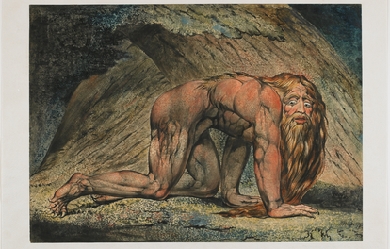
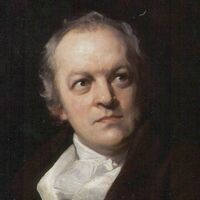
William Blake (28 November 1757 – 12 August 1827) was an English poet, painter, and printmaker. Largely unrecognised during his lifetime, Blake is now considered a seminal figure in the history of both the poetry and visual arts of the Romantic Age. His prophetic poetry has been said to form “what is in proportion to its merits the least read body of poetry in the English language”. His visual artistry has led one contemporary art critic to proclaim him “far and away the greatest artist Britain has ever produced”. Although he lived in London his entire life except for three years spent in Felpham he produced a diverse and symbolically rich corpus, which embraced the imagination as “the body of God”, or “Human existence itself”.
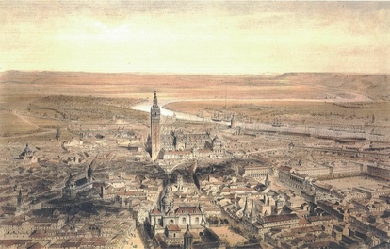
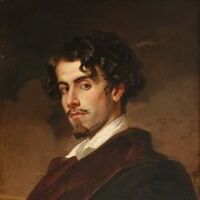
Gustavo Adolfo Domínguez Bastida (Sevilla, 17 de febrero de 1836 – Madrid, 22 de diciembre de 1870), más conocido como Gustavo Adolfo Bécquer, fue un poeta y narrador español, perteneciente al movimiento del Romanticismo, aunque escribió en una etapa literaria perteneciente al Realismo. Por ser un romántico tardío, ha sido asociado igualmente con el movimiento posromántico. Aunque, mientras vivió, fue moderadamente conocido, sólo comenzó a ganar verdadero prestigio cuando, tras su muerte, fueron publicadas muchas de sus obras. Nació en Sevilla el 17 de febrero de 1836, hijo del pintor José Domínguez Insausti, que firmaba sus cuadros con el apellido de sus antepasados como José Domínguez Bécquer. Sus más conocidos trabajos son sus Rimas y Leyendas. Los poemas e historias incluidos en esta colección son esenciales para el estudio de la Literatura hispana, siendo ampliamente reconocidos por su influencia posterior. Gustavo Adolfo por Mercedes de Velilla En la margen del Betis murmurante, donde expira, entre flores, la onda inquieta, en monumento digno del poeta, su hermosa estatua se alzará triunfante. El sol le ofrecerá nimbo radiante; sus perfumes, la rosa y la violeta; la aurora, el beso de su luz discreta; el crepúsculo, brisa refrescante. Traerá la noche espíritus y hadas, visiones de Leyendas peregrinas que poblarán las verdes enramadas. La alondra y las obscuras golondrinas cantarán, al lucir las alboradas, las Rimas inmortales y divinas.
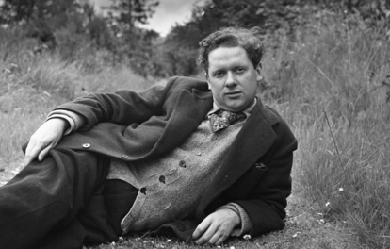

Dylan Marlais Thomas (27 October 1914 – 9 November 1953) was a Welsh poet and writer who wrote exclusively in English. In addition to poetry, he wrote short stories and scripts for film and radio, which he often performed himself. His public readings, particularly in America, won him great acclaim; his sonorous voice with a subtle Welsh lilt became almost as famous as his works. His best-known works include the “play for voices” Under Milk Wood and the celebrated villanelle for his dying father, “Do not go gentle into that good night”. Appreciative critics have also noted the craftsmanship and compression of poems such as “In my Craft or Sullen Art”, and the rhapsodic lyricism in “And death shall have no dominion” and “Fern Hill”.
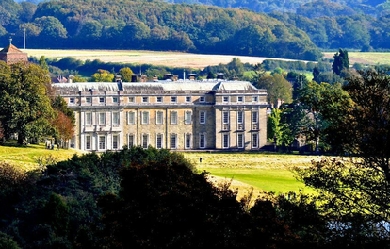
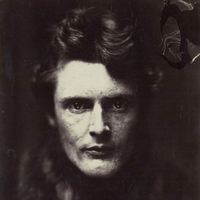
Wilfrid Scawen Blunt (17 August 1840– 10 September 1922) (sometimes spelled “Wilfred”) was an English poet and writer. He and his wife, Lady Anne Blunt travelled in the Middle East and were instrumental in preserving the Arabian horse bloodlines through their farm, the Crabbet Arabian Stud. He was best known for his poetry, which was published in a collected edition in 1914, but also wrote a number of political essays and polemics. Blunt is also known for his views against imperialism, viewed as relatively enlightened for his time. Early life Blunt was born at Petworth House in Sussex and served in the Diplomatic Service from 1858 to 1869. He was raised in the faith of his mother, a Catholic convert, and educated at Twyford School, Stonyhurst, and at St Mary’s College, Oscott. His most memorable line of poetry on the subject comes from Satan Absolved (1899), where the devil, answering a Kiplingesque remark by God, snaps back: ‘The white man’s burden, Lord, is the burden of his cash’ Here, Longford explains, 'Blunt stood Rudyard Kipling’s familiar concept on its head, arguing that the imperialists’ burden is not their moral responsibility for the colonised peoples, but their urge to make money out of them.' Personal life In 1869, Blunt married Lady Anne Noel, the daughter of the Earl of Lovelace and Ada Lovelace, and granddaughter of Lord Byron. Together the Blunts travelled through Spain, Algeria, Egypt, the Syrian Desert, and extensively in the Middle East and India. Based upon pure-blooded Arabian horses they obtained in Egypt and the Nejd, they co-founded Crabbet Arabian Stud, and later purchased a property near Cairo, named Sheykh Obeyd which housed their horse breeding operation in Egypt. In 1882, he championed the cause of Urabi Pasha, which led him to be banned from entering Egypt for four years. Blunt generally opposed British imperialism as a matter of philosophy, and his support for Irish causes led to his imprisonment in 1888. Wilfrid and Lady Anne’s only child to live to maturity was Judith Blunt-Lytton, 16th Baroness Wentworth, later known as Lady Wentworth. As an adult, she was married in Cairo but moved permanently to the Crabbet Park Estate in 1904. Wilfrid had a number of mistresses, among them a long term relationship with the courtesan Catherine “Skittles” Walters, and the Pre-Raphaelite beauty, Jane Morris. Eventually, he moved another mistress, Dorothy Carleton, into his home. This event triggered Lady Anne’s legal separation from him in 1906. At that time, Lady Anne signed a Deed of Partition drawn up by Wilfrid. Under its terms, unfavourable to Lady Anne, she kept the Crabbet Park property (where their daughter Judith lived) and half the horses, while Blunt took Caxtons Farm, also known as Newbuildings, and the rest of the stock. Always struggling with financial concerns and chemical dependency issues, Wilfrid sold off numerous horses to pay debts and constantly attempted to obtain additional assets. Lady Anne left the management of her properties to Judith, and spent many months of every year in Egypt at the Sheykh Obeyd estate, moving there permanently in 1915. Due primarily to the manoeuvering of Wilfrid in an attempt to disinherit Judith and obtain the entire Crabbet property for himself, Judith and her mother were estranged at the time of Lady Anne’s death in 1917. As a result, Lady Anne’s share of the Crabbet Stud passed to Judith’s daughters, under the oversight of an independent trustee. Blunt filed a lawsuit soon afterward. Ownership of the Arabian horses went back and forth between the estates of father and daughter in the following years. Blunt sold more horses to pay off debts and shot at least four in an attempt to spite his daughter, an action which required intervention of the trustee of the estate with a court injunction to prevent him from further “dissipating the assets” of the estate. The lawsuit was settled in favour of the granddaughters in 1920, and Judith bought their share from the trustee, combining it with her own assets and reuniting the stud. Father and daughter briefly reconciled shortly before Wilfrid Scawen Blunt’s death in 1922, but his promise to rewrite his will to restore Judith’s inheritance never materialised. Blunt was a friend of Winston Churchill, aiding him in his 1906 biography of his father, Randolph Churchill, whom Blunt had befriended years earlier in 1883 at a chess tournament. Work in Africa In the early 1880s, Britain was struggling with its Egyptian colony. Wilfrid Blunt was sent to notify Sir Edward Malet, the British agent, as to the Egyptian public opinion concerning the recent changes in government and development policies. In mid-December 1881, Blunt met with Ahmed ‘Urabi, known as Arabi or 'El Wahid’ (the Only One) due to his popularity with the Egyptians. Arabi was impressed with Blunt’s enthusiasm and appreciation of his culture. Their mutual respect created an environment in which Arabi could peacefully explain the reasoning behind a new patriotic movement, 'Egypt for the Egyptians’. Over the course of several days, Arabi explained the complicated background of the revolutionaries and their determination to rid themselves of the Turkish oligarchy. Wilfrid Blunt was vital in the relay of this information to the British empire although his anti-imperialist views were disregarded and England mounted further campaigns in the Sudan in 1885 and 1896–98. Egyptian Garden scandal In 1901, a pack of fox hounds was shipped over to Cairo to entertain the army officers, and subsequently a foxhunt took place in the desert near Cairo. The fox was chased into Blunt’s garden, and the hounds and hunt followed it. As well as a house and garden, the land contained the Blunt’s Sheykh Obeyd stud farm, housing a number of valuable Arabian horses. Blunt’s staff challenged the trespassers– who, though army officers, were not in uniform– and beat them when they refused to turn back. For this, the staff were accused of assault against army officers and imprisoned. Blunt made strenuous efforts to free his staff, much to the embarrassment of the British army officers and civil servants involved. Bibliography * Sonnets and Songs. By Proteus. John Murray, 1875 * Aubrey de Vere (ed.): Proteus and Amadeus: A Correspondence Kegan Paul, 1878 * The Love Sonnets of Proteus. Kegan Paul, 1881 * The Future of Islam Kegan Paul, Trench, London 1882 * Esther (1892) * Griselda Kegan Paul, Trench, Trübner, 1893 * The Quatrains of Youth (1898) * Satan Absolved: A Victorian Mystery. J. Lane, London 1899 * Seven Golden Odes of Pagan Arabia (1903) * Atrocities of Justice under the English Rule in Egypt. T. F. Unwin, London 1907. * Secret History of the English Occupation of Egypt Knopf, 1907 * India under Ripon; A Private Diary T. Fisher Unwin, London 1909. * Gordon at Khartoum. S. Swift, London 1911. * The Land War in Ireland. S. Swift, London 1912 * The Poetical Works. 2 Vols. . Macmillan, London 1914 * My Diaries. Secker, London 1919; 2 Vols. Knopf, New York 1921 References Wikipedia—https://en.wikipedia.org/wiki/Wilfrid_Scawen_Blunt


